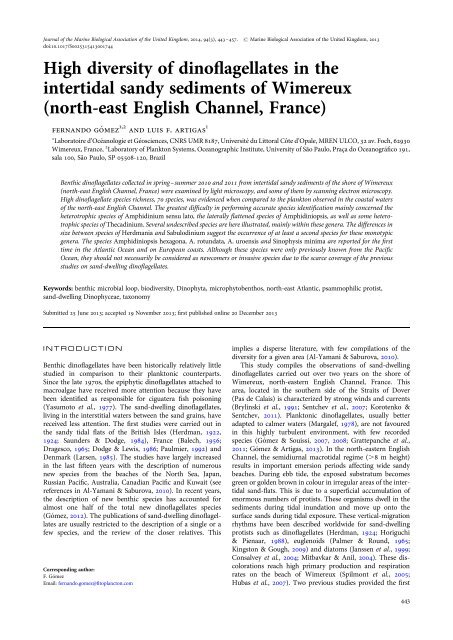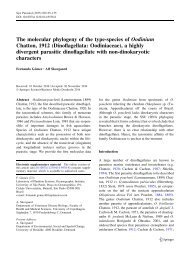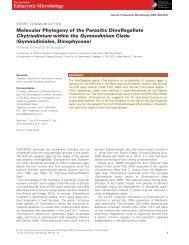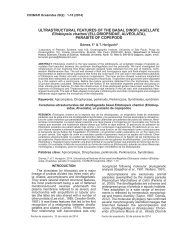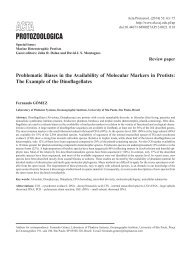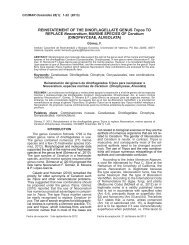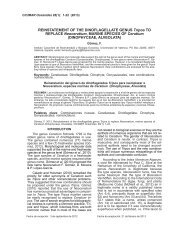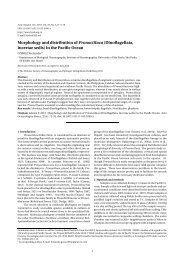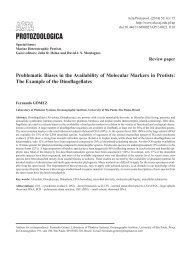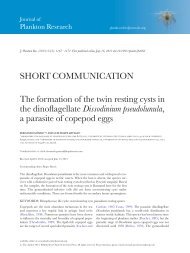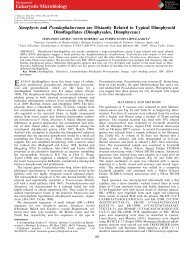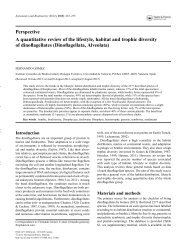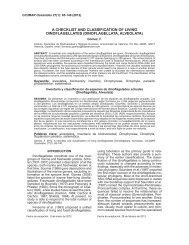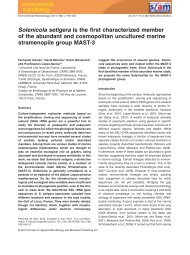High diversity of dinoflagellates in the intertidal sandy sediments of Wimereux (north-east English Channel, France)
Benthic dinoflagellates collected in spring–summer 2010 and 2011 from intertidal sandy sediments of the shore of Wimereux (north-east English Channel, France) were examined by light microscopy, and some of them by scanning electron microscopy. High dinoflagellate species richness, 70 species, was evidenced when compared to the plankton observed in the coastal waters of the north-east English Channel. The greatest difficulty in performing accurate species identification mainly concerned the heterotrophic species of Amphidinium sensu lato, the laterally flattened species of Amphidiniopsis, as well as some heterotrophic species of Thecadinium. Several undescribed species are here illustrated, mainly within these genera. The differences in size between species of Herdmania and Sabulodinium suggest the occurrence of at least a second species for these monotypic genera. The species Amphidiniopsis hexagona, A. rotundata, A. uroensis and Sinophysis minima are reported for the first time in the Atlantic Ocean and on European coasts. Although these species were only previously known from the Pacific Ocean, they should not necessarily be considered as newcomers or invasive species due to the scarce coverage of the previous studies on sand-dwelling dinoflagellates.
Benthic dinoflagellates collected in spring–summer 2010 and 2011 from intertidal sandy sediments of the shore of Wimereux
(north-east English Channel, France) were examined by light microscopy, and some of them by scanning electron microscopy.
High dinoflagellate species richness, 70 species, was evidenced when compared to the plankton observed in the coastal waters
of the north-east English Channel. The greatest difficulty in performing accurate species identification mainly concerned the
heterotrophic species of Amphidinium sensu lato, the laterally flattened species of Amphidiniopsis, as well as some heterotrophic
species of Thecadinium. Several undescribed species are here illustrated, mainly within these genera. The differences in
size between species of Herdmania and Sabulodinium suggest the occurrence of at least a second species for these monotypic
genera. The species Amphidiniopsis hexagona, A. rotundata, A. uroensis and Sinophysis minima are reported for the first
time in the Atlantic Ocean and on European coasts. Although these species were only previously known from the Pacific
Ocean, they should not necessarily be considered as newcomers or invasive species due to the scarce coverage of the previous
studies on sand-dwelling dinoflagellates.
Create successful ePaper yourself
Turn your PDF publications into a flip-book with our unique Google optimized e-Paper software.
Journal <strong>of</strong> <strong>the</strong> Mar<strong>in</strong>e Biological Association <strong>of</strong> <strong>the</strong> United K<strong>in</strong>gdom, 2014, 94(3), 443–457. # Mar<strong>in</strong>e Biological Association <strong>of</strong> <strong>the</strong> United K<strong>in</strong>gdom, 2013<br />
doi:10.1017/S0025315413001744<br />
<strong>High</strong> <strong>diversity</strong> <strong>of</strong> d<strong>in</strong><strong>of</strong>lagellates <strong>in</strong> <strong>the</strong><br />
<strong>in</strong>tertidal <strong>sandy</strong> <strong>sediments</strong> <strong>of</strong> <strong>Wimereux</strong><br />
(<strong>north</strong>-<strong>east</strong> <strong>English</strong> <strong>Channel</strong>, <strong>France</strong>)<br />
fernando go’ mez 1,2 and luis f. artigas 1<br />
1 Laboratoire d’Océanologie et Géosciences, CNRS UMR 8187, Université du Littoral Côte d’Opale, MREN ULCO, 32 av. Foch, 62930<br />
<strong>Wimereux</strong>, <strong>France</strong>, 2 Laboratory <strong>of</strong> Plankton Systems, Oceanographic Institute, University <strong>of</strong> São Paulo, Praça do Oceanográfico 191,<br />
sala 100, São Paulo, SP 05508-120, Brazil<br />
Benthic d<strong>in</strong><strong>of</strong>lagellates collected <strong>in</strong> spr<strong>in</strong>g–summer 2010 and 2011 from <strong>in</strong>tertidal <strong>sandy</strong> <strong>sediments</strong> <strong>of</strong> <strong>the</strong> shore <strong>of</strong> <strong>Wimereux</strong><br />
(<strong>north</strong>-<strong>east</strong> <strong>English</strong> <strong>Channel</strong>, <strong>France</strong>) were exam<strong>in</strong>ed by light microscopy, and some <strong>of</strong> <strong>the</strong>m by scann<strong>in</strong>g electron microscopy.<br />
<strong>High</strong> d<strong>in</strong><strong>of</strong>lagellate species richness, 70 species, was evidenced when compared to <strong>the</strong> plankton observed <strong>in</strong> <strong>the</strong> coastal waters<br />
<strong>of</strong> <strong>the</strong> <strong>north</strong>-<strong>east</strong> <strong>English</strong> <strong>Channel</strong>. The greatest difficulty <strong>in</strong> perform<strong>in</strong>g accurate species identification ma<strong>in</strong>ly concerned <strong>the</strong><br />
heterotrophic species <strong>of</strong> Amphid<strong>in</strong>ium sensu lato, <strong>the</strong> laterally flattened species <strong>of</strong> Amphid<strong>in</strong>iopsis, as well as some heterotrophic<br />
species <strong>of</strong> Thecad<strong>in</strong>ium. Several undescribed species are here illustrated, ma<strong>in</strong>ly with<strong>in</strong> <strong>the</strong>se genera. The differences <strong>in</strong><br />
size between species <strong>of</strong> Herdmania and Sabulod<strong>in</strong>ium suggest <strong>the</strong> occurrence <strong>of</strong> at l<strong>east</strong> a second species for <strong>the</strong>se monotypic<br />
genera. The species Amphid<strong>in</strong>iopsis hexagona, A. rotundata, A. uroensis and S<strong>in</strong>ophysis m<strong>in</strong>ima are reported for <strong>the</strong> first<br />
time <strong>in</strong> <strong>the</strong> Atlantic Ocean and on European coasts. Although <strong>the</strong>se species were only previously known from <strong>the</strong> Pacific<br />
Ocean, <strong>the</strong>y should not necessarily be considered as newcomers or <strong>in</strong>vasive species due to <strong>the</strong> scarce coverage <strong>of</strong> <strong>the</strong> previous<br />
studies on sand-dwell<strong>in</strong>g d<strong>in</strong><strong>of</strong>lagellates.<br />
Keywords: benthic microbial loop, bio<strong>diversity</strong>, D<strong>in</strong>ophyta, microphytobenthos, <strong>north</strong>-<strong>east</strong> Atlantic, psammophilic protist,<br />
sand-dwell<strong>in</strong>g D<strong>in</strong>ophyceae, taxonomy<br />
Submitted 25 June 2013; accepted 19 November 2013; first published onl<strong>in</strong>e 20 December 2013<br />
INTRODUCTION<br />
Benthic d<strong>in</strong><strong>of</strong>lagellates have been historically relatively little<br />
studied <strong>in</strong> comparison to <strong>the</strong>ir planktonic counterparts.<br />
S<strong>in</strong>ce <strong>the</strong> late 1970s, <strong>the</strong> epiphytic d<strong>in</strong><strong>of</strong>lagellates attached to<br />
macroalgae have received more attention because <strong>the</strong>y have<br />
been identified as responsible for ciguatera fish poison<strong>in</strong>g<br />
(Yasumoto et al., 1977). The sand-dwell<strong>in</strong>g d<strong>in</strong><strong>of</strong>lagellates,<br />
liv<strong>in</strong>g <strong>in</strong> <strong>the</strong> <strong>in</strong>terstitial waters between <strong>the</strong> sand gra<strong>in</strong>s, have<br />
received less attention. The first studies were carried out <strong>in</strong><br />
<strong>the</strong> <strong>sandy</strong> tidal flats <strong>of</strong> <strong>the</strong> British Isles (Herdman, 1922,<br />
1924; Saunders & Dodge, 1984), <strong>France</strong> (Balech, 1956;<br />
Dragesco, 1965; Dodge & Lewis, 1986; Paulmier, 1992) and<br />
Denmark (Larsen, 1985). The studies have largely <strong>in</strong>creased<br />
<strong>in</strong> <strong>the</strong> last fifteen years with <strong>the</strong> description <strong>of</strong> numerous<br />
new species from <strong>the</strong> beaches <strong>of</strong> <strong>the</strong> North Sea, Japan,<br />
Russian Pacific, Australia, Canadian Pacific and Kuwait (see<br />
references <strong>in</strong> Al-Yamani & Saburova, 2010). In recent years,<br />
<strong>the</strong> description <strong>of</strong> new benthic species has accounted for<br />
almost one half <strong>of</strong> <strong>the</strong> total new d<strong>in</strong><strong>of</strong>lagellates species<br />
(Gómez, 2012). The publications <strong>of</strong> sand-dwell<strong>in</strong>g d<strong>in</strong><strong>of</strong>lagellates<br />
are usually restricted to <strong>the</strong> description <strong>of</strong> a s<strong>in</strong>gle or a<br />
few species, and <strong>the</strong> review <strong>of</strong> <strong>the</strong> closer relatives. This<br />
Correspond<strong>in</strong>g author:<br />
F. Gómez<br />
Email: fernando.gomez@fitoplancton.com<br />
implies a disperse literature, with few compilations <strong>of</strong> <strong>the</strong><br />
<strong>diversity</strong> for a given area (Al-Yamani & Saburova, 2010).<br />
This study compiles <strong>the</strong> observations <strong>of</strong> sand-dwell<strong>in</strong>g<br />
d<strong>in</strong><strong>of</strong>lagellates carried out over two years on <strong>the</strong> shore <strong>of</strong><br />
<strong>Wimereux</strong>, <strong>north</strong>-<strong>east</strong>ern <strong>English</strong> <strong>Channel</strong>, <strong>France</strong>. This<br />
area, located <strong>in</strong> <strong>the</strong> sou<strong>the</strong>rn side <strong>of</strong> <strong>the</strong> Straits <strong>of</strong> Dover<br />
(Pas de Calais) is characterized by strong w<strong>in</strong>ds and currents<br />
(Bryl<strong>in</strong>ski et al., 1991; Sentchev et al., 2007; Korotenko &<br />
Sentchev, 2011). Planktonic d<strong>in</strong><strong>of</strong>lagellates, usually better<br />
adapted to calmer waters (Margalef, 1978), are not favoured<br />
<strong>in</strong> this highly turbulent environment, with few recorded<br />
species (Gómez & Souissi, 2007, 2008; Grattepanche et al.,<br />
2011; Gómez & Artigas, 2013). In <strong>the</strong> <strong>north</strong>-<strong>east</strong>ern <strong>English</strong><br />
<strong>Channel</strong>, <strong>the</strong> semidiurnal macrotidal regime (.8 m height)<br />
results <strong>in</strong> important emersion periods affect<strong>in</strong>g wide <strong>sandy</strong><br />
beaches. Dur<strong>in</strong>g ebb tide, <strong>the</strong> exposed substratum becomes<br />
green or golden brown <strong>in</strong> colour <strong>in</strong> irregular areas <strong>of</strong> <strong>the</strong> <strong>in</strong>tertidal<br />
sand-flats. This is due to a superficial accumulation <strong>of</strong><br />
enormous numbers <strong>of</strong> protists. These organisms dwell <strong>in</strong> <strong>the</strong><br />
<strong>sediments</strong> dur<strong>in</strong>g tidal <strong>in</strong>undation and move up onto <strong>the</strong><br />
surface sands dur<strong>in</strong>g tidal exposure. These vertical-migration<br />
rhythms have been described worldwide for sand-dwell<strong>in</strong>g<br />
protists such as d<strong>in</strong><strong>of</strong>lagellates (Herdman, 1924; Horiguchi<br />
& Pienaar, 1988), euglenoids (Palmer & Round, 1965;<br />
K<strong>in</strong>gston & Gough, 2009) and diatoms (Janssen et al., 1999;<br />
Consalvey et al., 2004; Mitbavkar & Anil, 2004). These discolorations<br />
reach high primary production and respiration<br />
rates on <strong>the</strong> beach <strong>of</strong> <strong>Wimereux</strong> (Spilmont et al., 2005;<br />
Hubas et al., 2007). Two previous studies provided <strong>the</strong> first<br />
443
444 fernando go’ mez and luis f. artigas<br />
molecular data <strong>of</strong> <strong>the</strong> d<strong>in</strong><strong>of</strong>lagellate genera Amphid<strong>in</strong>iopsis<br />
and S<strong>in</strong>ophysis (Gómez et al., 2011, 2012). However, <strong>the</strong> composition<br />
<strong>of</strong> <strong>the</strong> species has not yet been exam<strong>in</strong>ed.<br />
This study presents a first <strong>in</strong>ventory <strong>of</strong> <strong>the</strong> benthic d<strong>in</strong><strong>of</strong>lagellates<br />
<strong>in</strong> <strong>the</strong> region, with micrographs <strong>of</strong> several species that<br />
have not yet been described. Several species are illustrated for<br />
<strong>the</strong> first time <strong>in</strong> <strong>the</strong> area, s<strong>in</strong>ce <strong>the</strong>ir orig<strong>in</strong>al descriptions <strong>in</strong> <strong>the</strong><br />
Pacific Ocean. This constitutes <strong>the</strong> first observations <strong>of</strong> several<br />
species <strong>in</strong> <strong>the</strong> Atlantic Ocean and European seas.<br />
MATERIALS AND METHODS<br />
This study was undertaken <strong>in</strong> <strong>the</strong> s<strong>of</strong>t <strong>sandy</strong> <strong>sediments</strong> <strong>of</strong> <strong>the</strong><br />
shore <strong>of</strong> <strong>Wimereux</strong>, <strong>France</strong> (50846 ′ 12 ′′ N 1836 ′ 42 ′′ E) from<br />
March to October <strong>in</strong> 2010 and 2011. There were two sampl<strong>in</strong>g<br />
sites, <strong>the</strong> border <strong>of</strong> a large pool (≏50 m diameter, ≏1 m depth),<br />
and several smaller pools and moist sands with a fa<strong>in</strong>t brownish<br />
discoloration, <strong>in</strong> front <strong>of</strong> <strong>the</strong> LOG laboratory (MREN ULCO<br />
and Mar<strong>in</strong>e Station <strong>of</strong> <strong>Wimereux</strong> UL1). The upper centimetre<br />
<strong>of</strong> sand was collected with a spoon and deposited <strong>in</strong>to a bottle.<br />
There, <strong>the</strong> sand was r<strong>in</strong>sed with seawater and stirred vigorously,<br />
and <strong>the</strong> suspension settled <strong>in</strong> a composite settl<strong>in</strong>g chamber. The<br />
settled material was exam<strong>in</strong>ed with a Nikon <strong>in</strong>verted microscope<br />
(Nikon Eclipse TE2000-S) and photographed with a<br />
Nikon Digital Sight DS-2M camera.<br />
For scann<strong>in</strong>g electron microscopy, aliquots <strong>of</strong> <strong>the</strong> agitated<br />
sand samples were fixed with glutaraldehyde (5%) and filtered<br />
onto a 0.8 mm pore size Nucleopore membrane filter, washed<br />
with distilled water, fixed with osmium, dehydrated with a<br />
graded series <strong>of</strong> ethanol and critical-po<strong>in</strong>t-dried with CO 2 .<br />
Filters were mounted on stubs, sputter-coated with gold and<br />
viewed us<strong>in</strong>g a Hitachi S4800 scann<strong>in</strong>g electron microscope<br />
(SEM). Images were presented on a black background us<strong>in</strong>g<br />
Adobe Photoshop CS3.<br />
RESULTS<br />
The sand discolorations on <strong>the</strong> beach <strong>of</strong> <strong>Wimereux</strong> were more<br />
conspicuous dur<strong>in</strong>g sunny periods. There were two ma<strong>in</strong> types:<br />
green patches tended to occur <strong>in</strong> <strong>the</strong> upper limit <strong>of</strong> <strong>the</strong> eulittoral<br />
zone associated with monospecific proliferations <strong>of</strong> Euglena sp.,<br />
and greenish-brown patches were observed <strong>in</strong> moist sands <strong>in</strong><br />
<strong>the</strong> middle <strong>of</strong> <strong>the</strong> eulittoral zone and on <strong>the</strong> bottom <strong>of</strong> tidal<br />
pools. These patches were due to diatoms and photosyn<strong>the</strong>tic<br />
d<strong>in</strong><strong>of</strong>lagellates, ma<strong>in</strong>ly proliferations <strong>of</strong> Togula britannica, T.<br />
cf. compacta, Polykrikos lebouriae, Amphid<strong>in</strong>ium herdmanii,<br />
or more sporadically Sp<strong>in</strong>iferod<strong>in</strong>ium. A total <strong>of</strong> 70 species<br />
were found (Table 1). See video at: http://www.youtube.com/<br />
watch?v=BEjD-1wvBTs. A brief description <strong>of</strong> each species is<br />
provided below.<br />
Amphid<strong>in</strong>ium sensu lato<br />
Conspicuous patches <strong>in</strong> <strong>the</strong> <strong>sandy</strong> <strong>sediments</strong> <strong>of</strong> <strong>Wimereux</strong> were<br />
due to photosyn<strong>the</strong>tic species that were formerly described<br />
under <strong>the</strong> genus Amphid<strong>in</strong>ium. This unarmoured genus <strong>of</strong><br />
dorso-ventrally flattened species was traditionally def<strong>in</strong>ed by<br />
its small episome size, not exceed<strong>in</strong>g one third <strong>of</strong> <strong>the</strong> total<br />
cell length. Currently Amphid<strong>in</strong>ium sensu stricto is valid for<br />
species with m<strong>in</strong>ute irregular triangular or crescent-shaped<br />
episome, deflected to <strong>the</strong> left and overlaid <strong>in</strong> <strong>the</strong> anterior<br />
Table 1. List <strong>of</strong> sand-dwell<strong>in</strong>g d<strong>in</strong><strong>of</strong>lagellate species from <strong>the</strong> shore <strong>of</strong><br />
<strong>Wimereux</strong>, <strong>France</strong>.<br />
Taxa<br />
Adenoides eludens (Herdman) Balech<br />
Amphid<strong>in</strong>iopsis aculeata Hoppenrath, Koeman &<br />
B.S. Leander<br />
Amphid<strong>in</strong>iopsis arenaria Hoppenrath<br />
Amphid<strong>in</strong>iopsis cristata Hoppenrath<br />
Amphid<strong>in</strong>iopsis galericulata Hoppenrath<br />
Amphid<strong>in</strong>iopsis hexagona S. Yoshimatsu,<br />
S. Toriumi & J.D. Dodge<br />
Amphid<strong>in</strong>iopsis aff. hexagona ‘small form’<br />
Amphid<strong>in</strong>iopsis hirsuta (Balech) J.D. Dodge<br />
Amphid<strong>in</strong>iopsis rotundata Hoppenrath &<br />
M.S. Sel<strong>in</strong>a<br />
Amphid<strong>in</strong>iopsis sp. 1 ‘square’<br />
Amphid<strong>in</strong>iopsis sp. 2<br />
cf. Amphid<strong>in</strong>iopsis sp. 3<br />
cf. Amphid<strong>in</strong>iopsis sp. 4<br />
Amphid<strong>in</strong>iopsis swedmarkii (Balech) J.D. Dodge<br />
Amphid<strong>in</strong>iopsis uroensis S. Toriumi, S. Yoshimatsu<br />
& J.D. Dodge<br />
Amphid<strong>in</strong>ium bipes Herdman<br />
Amphid<strong>in</strong>ium carterae Hulburt<br />
Amphid<strong>in</strong>ium herdmanii K<strong>of</strong>. & Swezy<br />
Amphid<strong>in</strong>ium <strong>in</strong>coloratum P.H. Campb.<br />
Amphid<strong>in</strong>ium mootonorum Sh. Murray &<br />
D.J. Patterson<br />
Amphid<strong>in</strong>ium aff. operculatum Clap. & J. Lachm.<br />
Amphid<strong>in</strong>ium sp. 1 ‘heterotrophic form’<br />
Amphid<strong>in</strong>ium sp. 2 ‘round form’<br />
‘Amphid<strong>in</strong>ium’ scissum K<strong>of</strong>. & Swezy<br />
Amphid<strong>in</strong>ium sensu lato sp. 1 ‘with a granulate<br />
surface’<br />
Amphid<strong>in</strong>ium sensu lato sp. 2 ‘heterotrophic form’<br />
Amphid<strong>in</strong>ium sensu lato sp. 3 ‘heterotrophic form’<br />
Amphid<strong>in</strong>ium sensu lato sp. 4 ‘heterotrophic form’<br />
Amphid<strong>in</strong>ium sensu lato sp. 5 ‘heterotrophic form’<br />
Amphid<strong>in</strong>ium sensu lato sp. 6 ‘heterotrophic form’<br />
Amphid<strong>in</strong>ium sensu lato sp. 7 ‘photosyn<strong>the</strong>tic form’<br />
Amphid<strong>in</strong>ium sensu lato sp. 8 ‘photosyn<strong>the</strong>tic form’<br />
Amphid<strong>in</strong>ium sensu lato aff. A. manann<strong>in</strong>ii<br />
‘photosyn<strong>the</strong>tic form’<br />
Ankistrod<strong>in</strong>ium semilunatum (Herdman) Hoppenrath,<br />
Sh. Murray, Sparmann & B.S. Leander<br />
Apicoporus glaber (Hoppenrath & Okolodkov)<br />
S.F. Sparmann, B.S. Leander & Hoppenrath<br />
cf. Apicoporus sp.<br />
gymnod<strong>in</strong>ioid species 1<br />
gymnod<strong>in</strong>ioid species 2<br />
Gymnod<strong>in</strong>ium venator Flø Jørg. & Sh. Murray<br />
Herdmania litoralis J.D. Dodge ‘large form’<br />
Herdmania litoralis J.D. Dodge ‘small form’<br />
cf. Herdmania sp. ‘lack<strong>in</strong>g apical notch’<br />
Katod<strong>in</strong>ium asymmetricum (Massart) Loebl.<br />
Katod<strong>in</strong>ium glandula (Herdman) A.R. Loebl.<br />
Planod<strong>in</strong>ium striatum R.D. Saunders & J.D. Dodge<br />
Polykrikos herdmaniae Hoppenrath & B.S. Leander<br />
Polykrikos lebouriae Herdman<br />
Prorocentrum fukuyoi Sh. Murray & Y. Nagah.<br />
Sabulod<strong>in</strong>ium sp. ‘small form’<br />
Sabulod<strong>in</strong>ium undulatum var. glabromarg<strong>in</strong>atum<br />
Sabulod<strong>in</strong>ium undulatum var. undulatum<br />
S<strong>in</strong>ophysis ebriola (Herdman) Balech<br />
S<strong>in</strong>ophysis aff. grandis<br />
S<strong>in</strong>ophysis grandis Hoppenrath<br />
Figure<br />
8A–F<br />
3J–L<br />
4A–E<br />
3X–AE<br />
4F–I<br />
3M–O<br />
3P, Q<br />
3A–F<br />
3AF–AI<br />
3T, U<br />
3V, W<br />
4J–M<br />
4N, O<br />
3G–I<br />
3R, S<br />
1I–K<br />
1A–C<br />
1D, E<br />
1M<br />
1G, H<br />
1F<br />
1L<br />
1N<br />
1AA–AC<br />
1AD, AE<br />
1O, P<br />
1Q<br />
1R<br />
1S<br />
1T<br />
1AX<br />
1AY<br />
1AZ<br />
1AF–AK<br />
1W, X<br />
1Z<br />
2E<br />
2F<br />
2A–E<br />
4P, Q, T, U<br />
4P–S<br />
4X, Y<br />
8X, Y<br />
8S–W<br />
6P–Y<br />
2G–K<br />
2L–O<br />
8G–R<br />
6N, O<br />
6A–G<br />
6H–M<br />
7A–G<br />
7J–M<br />
7N–Q<br />
Cont<strong>in</strong>ued
sand-dwell<strong>in</strong>g d<strong>in</strong><strong>of</strong>lagellates from wimereux 445<br />
Taxa<br />
Table 1. Cont<strong>in</strong>ued<br />
S<strong>in</strong>ophysis m<strong>in</strong>ima M.S. Sel<strong>in</strong>a & Hoppenrath<br />
S<strong>in</strong>ophysis sp. ‘with dorsal lobule’<br />
S<strong>in</strong>ophysis stenosoma Hoppenrath<br />
S<strong>in</strong>ophysis cf. verruculosa Chómerat & Nézan<br />
Sp<strong>in</strong>iferod<strong>in</strong>ium galeiforme T. Horig. & Chihara<br />
Testudod<strong>in</strong>ium sp.<br />
Thecad<strong>in</strong>ium acanthium Hoppenrath<br />
Thecad<strong>in</strong>ium <strong>in</strong>cl<strong>in</strong>atum Balech<br />
Thecad<strong>in</strong>ium k<strong>of</strong>oidii (Herdman) J. Larsen<br />
Thecad<strong>in</strong>ium neopetasatum R.D. Saunders &<br />
J.D. Dodge<br />
Thecad<strong>in</strong>ium sp.<br />
Thecad<strong>in</strong>ium yashimaense S. Yoshimatsu, S. Toriumi<br />
& J.D. Dodge<br />
Togula britannica (Herdman) Flø Jørg., Sh. Murray &<br />
Daugbjerg<br />
Togula cf. compacta (Herdman) Flø Jørg., Sh. Murray &<br />
Daugbjerg<br />
Unidentified cf. Togula sp. 1<br />
Unidentified cf. Togula sp. 2<br />
ventral part <strong>of</strong> <strong>the</strong> hyposome (as def<strong>in</strong>ed by Flø Jørgensen et al.,<br />
2004). O<strong>the</strong>r Amphid<strong>in</strong>ium species have been transferred <strong>in</strong>to<br />
<strong>the</strong> genus Gymnod<strong>in</strong>ium (i.e. G. venator), new genera<br />
(Ankistrod<strong>in</strong>ium, Apicoporus, Bisp<strong>in</strong>od<strong>in</strong>ium, Testudod<strong>in</strong>ium,<br />
Togula) and o<strong>the</strong>r species also need to be placed <strong>in</strong>to a separate<br />
genus (i.e. Amphid<strong>in</strong>ium scissum).<br />
Amphid<strong>in</strong>ium sensu stricto<br />
Figure<br />
7T–V<br />
7I<br />
7R, S<br />
7H<br />
2P–T<br />
1U, V<br />
5L–P<br />
5V–Y<br />
5A–E<br />
5F, G<br />
5H–K<br />
5Q–U<br />
1AL, AM<br />
1AN–AR<br />
1AV<br />
1AW<br />
The photosyn<strong>the</strong>tic species Amphid<strong>in</strong>ium carterae, A. operculatum<br />
and A. herdmanii are characterized by a small episome,<br />
crescent-shaped and deflected towards <strong>the</strong> left. The cells <strong>of</strong><br />
Amphid<strong>in</strong>ium carterae are oval, more or less elongated, 13–<br />
15 mm long and 9–13 mm wide (Figure 1A–C). When compared<br />
to A. operculatum and A. herdmanii, <strong>the</strong> shape <strong>of</strong> <strong>the</strong><br />
hyposome <strong>of</strong> A. carterae is more asymmetrical, with <strong>the</strong><br />
episome closer to <strong>the</strong> right side <strong>of</strong> <strong>the</strong> cell (Figure 1A–C).<br />
The species A. carterae, A. massartii and A. <strong>the</strong>rmaeum are<br />
highly morphologically similar, overlapp<strong>in</strong>g completely <strong>in</strong><br />
size range and <strong>in</strong> shape. Accord<strong>in</strong>g to Murray et al. (2012)<br />
<strong>the</strong>se three species can be dist<strong>in</strong>guished on <strong>the</strong> basis <strong>of</strong> <strong>the</strong><br />
shape <strong>of</strong> <strong>the</strong> plastid—which is reticulate and distributed<br />
throughout <strong>the</strong> whole cell area <strong>in</strong> A. carterae, but generally<br />
more sparse, with several lobes, <strong>in</strong> A. massartii and A. <strong>the</strong>rmaeum—and<br />
<strong>the</strong> slightly lower position <strong>of</strong> flagellar <strong>in</strong>sertion<br />
<strong>in</strong> A. massartii and A. <strong>the</strong>rmaeum compared to A. carterae.<br />
The cells <strong>of</strong> A. operculatum and A. herdmanii are oval,<br />
oblong to egg-shaped from <strong>the</strong> ventral side, length about<br />
25 mm and width about 20 mm. The species A. herdmanii<br />
has been illustrated <strong>in</strong> <strong>the</strong> literature with different morphologies<br />
(Schiller, 1933, figure 238a–f). We consider that<br />
A. herdmanii corresponds to <strong>the</strong> first illustration by<br />
Herdman (1922, figure 8a). The episome <strong>of</strong> A. herdmanii is<br />
symmetrical and protrudes over <strong>the</strong> hyposome. The hyposome<br />
is slightly asymmetrical, with <strong>the</strong> left side longer than<br />
<strong>the</strong> right one, appear<strong>in</strong>g <strong>in</strong>dented at <strong>the</strong> antapex by <strong>the</strong><br />
sulcus (Figure 1D, E). Consequently, A. herdmanii shows a<br />
slightly bi-lobulated antapex <strong>in</strong> comparison to A. operculatum.<br />
The specimens <strong>of</strong> Figure 1F show <strong>the</strong> cell shape <strong>of</strong><br />
A. operculatum. However, <strong>the</strong>y are named Amphid<strong>in</strong>ium aff.<br />
operculatum because <strong>the</strong> episome is wider than <strong>in</strong> <strong>the</strong> orig<strong>in</strong>al<br />
description <strong>of</strong> A. operculatum (Figure 1F). The cells <strong>of</strong> A. mootonorum<br />
differ from o<strong>the</strong>r species <strong>of</strong> Amphid<strong>in</strong>ium sensu<br />
stricto <strong>in</strong> <strong>the</strong> episome, which does not project beyond <strong>the</strong><br />
outl<strong>in</strong>e <strong>of</strong> <strong>the</strong> cell. The c<strong>in</strong>gulum is V-shaped and encircles<br />
<strong>the</strong> episome (Figure 1G, H). The nucleus is usually posteriorly<br />
located <strong>in</strong> <strong>the</strong> species <strong>of</strong> Amphid<strong>in</strong>ium sensu stricto. However,<br />
<strong>the</strong> nucleus <strong>of</strong> A. mootonorum is located <strong>in</strong> <strong>the</strong> middle <strong>of</strong> <strong>the</strong><br />
cell (Figure 1G, H). This species can be easily confused with<br />
Testudod<strong>in</strong>ium testudo.<br />
There is less <strong>in</strong>formation on <strong>the</strong> heterotrophic species <strong>of</strong><br />
Amphid<strong>in</strong>ium when compared to <strong>the</strong> photosyn<strong>the</strong>tic ones,<br />
because <strong>the</strong>y do not form large proliferations and because <strong>of</strong><br />
<strong>the</strong> difficulties <strong>of</strong> establish<strong>in</strong>g cultures. Amphid<strong>in</strong>ium bipes is<br />
one <strong>of</strong> <strong>the</strong> most dist<strong>in</strong>ctive heterotrophic species <strong>of</strong><br />
Amphid<strong>in</strong>ium because <strong>the</strong> hyposome is divided <strong>in</strong>to two<br />
rounded antapical lobes (Figure 1I–K). The differentiation<br />
among o<strong>the</strong>r heterotrophic species <strong>of</strong> Amphid<strong>in</strong>ium is more<br />
difficult. Figure 1L illustrates a specimen <strong>of</strong> similar size to<br />
A. bipes, with a similar episome that protrudes over <strong>the</strong> hyposome.<br />
The ma<strong>in</strong> difference is <strong>the</strong> oblong rectangular shape <strong>of</strong><br />
<strong>the</strong> hyposome (Figure 1L). We are unable to assign this specimen<br />
to any known species.<br />
Amphid<strong>in</strong>ium <strong>in</strong>coloratum shows an oval hyposome,<br />
asymmetrical, relatively straight, with <strong>the</strong> right side convex<br />
(Figure 1M). The small episome slightly protrudes over <strong>the</strong><br />
hyposome. The cell is about 32 mm long and 20 mm wide<br />
(Figure 1M). Figure 1N illustrates a specimen exam<strong>in</strong>ed by<br />
scann<strong>in</strong>g electron microscopy. It was not observed by light<br />
microscopy, and we were unable to determ<strong>in</strong>ate <strong>the</strong> presence<br />
<strong>of</strong> plastids. The episome is flat, 6 mm wide, and it protrudes<br />
over <strong>the</strong> hyposome, as typical <strong>in</strong> Amphid<strong>in</strong>ium sensu stricto<br />
(Figure 1N). The most dist<strong>in</strong>ctive character is a round cell<br />
body (diameter <strong>of</strong> 20 mm). We are unable to assign this specimen<br />
to any known species.<br />
heterotrophic species <strong>of</strong> amphid<strong>in</strong>ium sensu<br />
lato<br />
Several heterotrophic species show a flat episome that slightly<br />
protrudes over <strong>the</strong> hyposome. The shape <strong>of</strong> <strong>the</strong> hyposome<br />
varies from ovate (Figure 1O, P), or rounder with <strong>the</strong> antapical<br />
marg<strong>in</strong> slightly divided <strong>in</strong>to two rounded lobes (Figure 1Q).<br />
O<strong>the</strong>r heterotrophic specimens show an episome almost<br />
embedded <strong>in</strong> <strong>the</strong> hyposome (Figure 1R–T). The shape <strong>of</strong><br />
<strong>the</strong> hyposome ranges from oval (Figure 1R, S) to elongate<br />
with a slightly po<strong>in</strong>ted antapex (Figure 1T). We are unable<br />
to assign <strong>the</strong>se specimens to known species.<br />
genus testudod<strong>in</strong>ium<br />
The genus Testudod<strong>in</strong>ium has been recently proposed for a<br />
species with a small episome that does not project beyond <strong>the</strong><br />
outl<strong>in</strong>e <strong>of</strong> <strong>the</strong> cell. The c<strong>in</strong>gulum is V-shaped and encircles <strong>the</strong><br />
episome. The sulcus is about one-third <strong>of</strong> <strong>the</strong> total cell length<br />
and is located at <strong>the</strong> centre <strong>of</strong> <strong>the</strong> hyposome. This morphology<br />
is close to <strong>the</strong> species Amphid<strong>in</strong>ium mootonorum which has <strong>the</strong><br />
nucleus located <strong>in</strong> <strong>the</strong> middle <strong>of</strong> <strong>the</strong> cell (Figure 1G, H). We<br />
found a species that fits <strong>the</strong> characteristics <strong>of</strong> <strong>the</strong> genus<br />
(Figure 1U, V). The small episome is embedded <strong>in</strong> <strong>the</strong> hyposome,<br />
protrud<strong>in</strong>g from <strong>the</strong> hyposome on <strong>the</strong> ventral side. The<br />
hyposome is elongated with a slightly po<strong>in</strong>ted marg<strong>in</strong>. The<br />
specimen shows a brownish pigmentation (Figure 1U, V).
446 fernando go’ mez and luis f. artigas<br />
Fig. 1. Micrographs <strong>of</strong> unarmoured sand-dwell<strong>in</strong>g d<strong>in</strong><strong>of</strong>lagellates from <strong>the</strong> shore <strong>of</strong> <strong>Wimereux</strong>: (A–C) Amphid<strong>in</strong>ium carterae; (D, E) Amphid<strong>in</strong>ium herdmanii;<br />
(F) Amphid<strong>in</strong>ium aff. operculatum – <strong>the</strong> arrow po<strong>in</strong>ts to an orange spot; (G, H) Amphid<strong>in</strong>ium mootonorum; (I–K)Amphid<strong>in</strong>ium bipes; (L) unidentified<br />
heterotrophic Amphid<strong>in</strong>ium; (M) Amphid<strong>in</strong>ium <strong>in</strong>coloratum; (N) unidentified round Amphid<strong>in</strong>ium; (O–T) several unidentified heterotrophic species <strong>of</strong><br />
Amphid<strong>in</strong>ium sensu lato (see Table 1); (U, V) Testudod<strong>in</strong>ium sp.; (W, X) Apicoporus glaber; (Z) cf. Apicoporus sp.; (AA–AC) ‘Amphid<strong>in</strong>ium’ scissum; (AD,<br />
AE) unidentified species with granulate surface; (AF–AK) Ankistrod<strong>in</strong>ium semilunatum; (AL, AM) Togula britannica; (AO–AR) Togula cf. compacta; (AS)<br />
Togula <strong>in</strong>side a hyal<strong>in</strong>e capsule; (AT, AU) ameboid cells <strong>of</strong> Togula; (AV–AY) unidentified photosyn<strong>the</strong>tic species <strong>of</strong> Amphid<strong>in</strong>ium sensu lato (see Table 1);<br />
(AZ) photosyn<strong>the</strong>tic species close to Amphid<strong>in</strong>ium manann<strong>in</strong>ii. Scale bar: 10 mm.<br />
genus apicoporus<br />
The heterotrophic species Apicoporus glaber (¼Amphid<strong>in</strong>ium<br />
gabrum) is characterized by a small, low, wide, beak-shaped,<br />
asymmetrical episome. The cells shows an oblong shape<br />
(Figure 1W, X). The specimen <strong>in</strong> Figure 1Z shows a low<br />
episome and a smooth cell surface, as <strong>in</strong> Apicoporus. The<br />
cell shows a po<strong>in</strong>ted antapical marg<strong>in</strong>, as <strong>in</strong> Amphid<strong>in</strong>ium<br />
scissum (Figure 1Z).<br />
amphid<strong>in</strong>ium sensu lato: genus<strong>of</strong><br />
‘amphid<strong>in</strong>ium’ scissum<br />
The species <strong>of</strong> Amphid<strong>in</strong>ium sensu stricto have a smooth cell<br />
surface. The shape <strong>of</strong> <strong>the</strong> episome <strong>of</strong> A. scissum does not<br />
match with <strong>the</strong> recent def<strong>in</strong>ition <strong>of</strong> Amphid<strong>in</strong>ium sensu<br />
stricto, and it also differs <strong>in</strong> <strong>the</strong> surface striation, with f<strong>in</strong>e<br />
longitud<strong>in</strong>al striations that resemble <strong>the</strong> genus Gyrod<strong>in</strong>ium<br />
(Figure 1AA–AC).<br />
amphid<strong>in</strong>ium sensu lato: unidentified genus<br />
with granulate surface<br />
Figure 1AD illustrates a specimen found <strong>in</strong> a sample exam<strong>in</strong>ed<br />
by scann<strong>in</strong>g electron microscopy. The hyposome is slightly<br />
bifurcated. The most characteristic feature is a cell surface<br />
covered with homogeneous rounded granules (Figure 1AE).<br />
To <strong>the</strong> best <strong>of</strong> our knowledge, this type <strong>of</strong> surface ornamentation<br />
is unknown for species <strong>of</strong> Amphid<strong>in</strong>ium sensu lato.
sand-dwell<strong>in</strong>g d<strong>in</strong><strong>of</strong>lagellates from wimereux 447<br />
genus ankistrod<strong>in</strong>ium<br />
The cells <strong>of</strong> Ankistrod<strong>in</strong>ium semilunatum are oval to oblongshaped<br />
<strong>in</strong> lateral view, strongly laterally compressed. The c<strong>in</strong>gulum<br />
rises from its orig<strong>in</strong> towards <strong>the</strong> dorsal side <strong>of</strong> <strong>the</strong> cell,<br />
<strong>the</strong>n tilts downwards slightly. The cell size varies from 30 to<br />
50 mm long and from 20 to 30 mm wide. This heterotrophic<br />
species usually shows food particles (Figure 1AF–AK).<br />
genus togula<br />
The most conspicuous discolorations <strong>in</strong> <strong>the</strong> moist sands <strong>of</strong><br />
<strong>Wimereux</strong> are due to species <strong>of</strong> <strong>the</strong> genus Togula. The cells<br />
are highly pigmented with irregular greenish-yellow chloroplast<br />
lobes radiat<strong>in</strong>g from <strong>the</strong> centre towards <strong>the</strong> periphery.<br />
The episome and hyposome are asymmetrical. The c<strong>in</strong>gulum<br />
orig<strong>in</strong>ates posteriorly to centrally, tak<strong>in</strong>g an anterior straight<br />
course, turn<strong>in</strong>g left from <strong>the</strong> apex and descend<strong>in</strong>g <strong>in</strong> a<br />
sigmoid-straight fashion dorsally, descend<strong>in</strong>g <strong>in</strong> a straight<br />
course upon reach<strong>in</strong>g <strong>the</strong> ventral side.<br />
The genus currently accounts for three species: Togula britannica,<br />
T. compacta and T. jolla. Togula britannica<br />
(Figure 1AL, AM) can be identified by its larger size, and by<br />
its slimmer appearance when compared to <strong>the</strong> smaller<br />
species T. cf. compacta (Figure 1AN–AR). The dist<strong>in</strong>ction<br />
between T. compacta, T. jolla and Amphid<strong>in</strong>ium ovum is difficult.<br />
The motile cells <strong>of</strong> Togula cf. compacta are broadly ellipsoidal<br />
<strong>in</strong> <strong>the</strong> dorso-ventral view, with <strong>the</strong> width <strong>of</strong> <strong>the</strong> episome<br />
a little less than <strong>the</strong> width <strong>of</strong> <strong>the</strong> hyposome, and golden-brown<br />
to dark-brown <strong>in</strong> colour. The apex and antapex are broadly<br />
rounded, but <strong>the</strong> antapex can appear slightly po<strong>in</strong>ted <strong>in</strong> <strong>the</strong><br />
dorsal view (Figure 1AN–AR). Dur<strong>in</strong>g cell division <strong>in</strong><br />
<strong>the</strong> genus Togula <strong>the</strong> two daughter cells <strong>in</strong>itially separate at<br />
<strong>the</strong> antapex, and <strong>the</strong> epicones are <strong>the</strong> last parts to split<br />
(Figure 1AL, AP). It was common to observe immotile cells<br />
surrounded by a hyal<strong>in</strong>e sheath. These immotile cells tended<br />
to be broader than <strong>the</strong> motile cells (Figure 1AS). A short<br />
period <strong>of</strong> metabolic movement occurred dur<strong>in</strong>g <strong>the</strong> change<br />
from immotile to motile cell (Figure 1AT, AU).<br />
unidentified photosyn<strong>the</strong>tic species <strong>of</strong><br />
amphid<strong>in</strong>ium sensu lato<br />
Figure 1AV–AY represents several unidentified species that<br />
superficially resemble Togula. Much research is needed to<br />
facilitate <strong>the</strong> dist<strong>in</strong>ction between <strong>the</strong>se species under rout<strong>in</strong>e<br />
microscopical analysis. Figure 1AZ illustrates a small cell<br />
(20 mm long) with yellowish pigmentation resembl<strong>in</strong>g <strong>the</strong> heterotrophic<br />
species Amphid<strong>in</strong>ium manann<strong>in</strong>ii. The cell body is<br />
broadly ellipsoidal, <strong>the</strong> episome angular and <strong>the</strong> hyposome<br />
cordate with a rounded po<strong>in</strong>t at <strong>the</strong> antapex. The morphology<br />
<strong>of</strong> <strong>the</strong> episome does not match with <strong>the</strong> current def<strong>in</strong>ition <strong>of</strong><br />
Amphid<strong>in</strong>ium sensu stricto. The species A. manann<strong>in</strong>ii is<br />
described as colourless, while this specimen shows yellowishbrown<br />
pigmentation that suggests <strong>the</strong> occurrence <strong>of</strong> plastids<br />
(Figure 1AZ).<br />
Family Gymnod<strong>in</strong>iaceae<br />
The cells <strong>of</strong> <strong>the</strong> heterotrophic species Gymnod<strong>in</strong>ium venator<br />
(¼Amphid<strong>in</strong>ium pellucidum) are oval to oblong from <strong>the</strong><br />
ventral side. Coloured food particles and colourless lipid globules<br />
were <strong>of</strong>ten present. The length is variable from 30 to<br />
35 mm and <strong>the</strong> width from 15 to 25 mm (Figure 2A–E). A<br />
closely related species, Amphid<strong>in</strong>ium flexum, is described by<br />
Herdman as rectangular <strong>in</strong> shape. The species Amphid<strong>in</strong>ium<br />
latum shows a cone-shaped episome with a po<strong>in</strong>ted apex.<br />
The shorter and flattened episome is <strong>the</strong> ma<strong>in</strong> characteristic<br />
<strong>of</strong> G. venator when compared to Amphid<strong>in</strong>ium latum.<br />
Figure 2F shows two specimens <strong>of</strong> different sizes which correspond<br />
to an unidentified species.<br />
genus polykrikos<br />
A photosyn<strong>the</strong>tic species <strong>of</strong> Polykrikos was also responsible for<br />
discolorations <strong>in</strong> <strong>the</strong> moist sands <strong>of</strong> <strong>the</strong> beach at <strong>Wimereux</strong>,<br />
and was more usually found <strong>in</strong> <strong>the</strong> bottom <strong>of</strong> tidal pools<br />
dur<strong>in</strong>g low water. Polykrikos is a dist<strong>in</strong>ctive genus <strong>of</strong> pseudocolonies<br />
consist<strong>in</strong>g <strong>of</strong> eight zooids, sometimes four zooids.<br />
Currently, <strong>the</strong>re are two benthic species with<strong>in</strong> this genus:<br />
Polykrikos lebouriae and Polykrikos herdmaniae. The morphological<br />
dist<strong>in</strong>ction is <strong>the</strong> presence <strong>of</strong> plastids <strong>in</strong> P. lebouriae.<br />
Both species conta<strong>in</strong>ed red coloured food bodies <strong>of</strong> variable<br />
number and size that were positioned <strong>in</strong> different areas <strong>of</strong><br />
<strong>the</strong> pseudo-colony. The transparency <strong>of</strong> <strong>the</strong> heterotrophic<br />
P. herdmaniae (Figure 2G–K) facilitated observation <strong>of</strong> <strong>the</strong><br />
taeniocyst–nematocyst complexes that were less prom<strong>in</strong>ent<br />
<strong>in</strong> <strong>the</strong> photosyn<strong>the</strong>tic P. lebouriae (Figure 2L–O).<br />
The photosyn<strong>the</strong>tic P. lebouriae shows a high variability <strong>in</strong><br />
cell size, rang<strong>in</strong>g from 40 to 90 mm long and from 20 to 50 mm<br />
wide (Figure 2L–O). The pseudo-colonies were ovate <strong>in</strong> shape<br />
and obliquely flattened, with term<strong>in</strong>al zooids about half as<br />
wide as central zooids. The heterotrophic P. herdmaniae<br />
(Figure 2G–K) did not form proliferations, and ma<strong>in</strong>ly<br />
appeared <strong>in</strong> <strong>the</strong> proliferations <strong>of</strong> Togula and Polykrikos<br />
lebouriae.<br />
genus sp<strong>in</strong>iferod<strong>in</strong>ium<br />
This genus was highly dist<strong>in</strong>ctive <strong>in</strong> its immotile stage because<br />
it formed a sp<strong>in</strong>e shell and was strongly attached to <strong>the</strong> substrate<br />
(Figure 2Q–T). In contrast, <strong>the</strong> motile form can be<br />
easily confused with typical photosyn<strong>the</strong>tic Gymnod<strong>in</strong>iumlike<br />
cells (Figure 2P). Sp<strong>in</strong>iferod<strong>in</strong>ium appeared <strong>in</strong> sands permanently<br />
covered by water dur<strong>in</strong>g low tide, such as <strong>the</strong><br />
bottom <strong>of</strong> tidal pools. The presence <strong>of</strong> Sp<strong>in</strong>iferod<strong>in</strong>ium was<br />
sporadic. However, its presence was always associated with<br />
large proliferations, where Sp<strong>in</strong>iferod<strong>in</strong>ium was <strong>the</strong> ma<strong>in</strong><br />
photosyn<strong>the</strong>tic species. The observations <strong>of</strong> live cells under<br />
<strong>the</strong> microscope revealed that <strong>the</strong> switch from <strong>the</strong> swimm<strong>in</strong>g<br />
form to <strong>the</strong> immotile cells is very fast. In <strong>the</strong> settl<strong>in</strong>g<br />
chamber, <strong>the</strong> motile cells stopped swimm<strong>in</strong>g, settled on <strong>the</strong><br />
bottom, and <strong>in</strong> less than 2 s <strong>the</strong> cell acquired a flattened<br />
round shape covered by a transparent, sp<strong>in</strong>y helmet shell.<br />
The cell strongly attached itself to <strong>the</strong> surface <strong>of</strong> substratum.<br />
Without doubt, this is a mechanism to avoid re-suspension<br />
<strong>in</strong> <strong>the</strong> water column.<br />
It was quite easy to identify <strong>the</strong> genus Sp<strong>in</strong>iferod<strong>in</strong>ium<br />
based on <strong>the</strong> observations <strong>of</strong> <strong>the</strong> immotile sp<strong>in</strong>y stages.<br />
However, it was difficult to differentiate between <strong>the</strong> two<br />
species described to date (<strong>the</strong> type Sp<strong>in</strong>iferod<strong>in</strong>ium galeiforme<br />
and S. palauense). Accord<strong>in</strong>g to <strong>the</strong> orig<strong>in</strong>al description, S.<br />
palauense shows a th<strong>in</strong>ner cell body, <strong>the</strong> c<strong>in</strong>gulum is slightly<br />
displaced and <strong>the</strong> episome is smaller than <strong>the</strong> hyposome.<br />
The c<strong>in</strong>gulum <strong>of</strong> S. galeiforme is not displaced and is located<br />
almost <strong>in</strong> <strong>the</strong> middle <strong>of</strong> <strong>the</strong> cell (as reported by Horiguchi<br />
et al., 2011) (Figure 2R–T). The specimens observed on <strong>the</strong><br />
beach <strong>of</strong> <strong>Wimereux</strong> have been assigned to S. galeiforme<br />
(Figure 2P–T).
448 fernando go’ mez and luis f. artigas<br />
Fig. 2. Micrographs <strong>of</strong> unarmoured sand-dwell<strong>in</strong>g d<strong>in</strong><strong>of</strong>lagellates from <strong>the</strong> shore <strong>of</strong> <strong>Wimereux</strong>: (A–D) Gymnod<strong>in</strong>ium venator; (E) Gymndo<strong>in</strong>ium venator (small)<br />
and an unidentified gymnod<strong>in</strong>ioid species; (F) unidentified gymnod<strong>in</strong>ioid species; (G–K) Polykrikos herdmaniae; (L–O) Polykrikos lebouriae; (P–T)<br />
Sp<strong>in</strong>iferod<strong>in</strong>ium galeiforme. Scale bar: 10 mm.<br />
Family Amphid<strong>in</strong>iopsidaceae<br />
genus amphid<strong>in</strong>iopsis<br />
Amphid<strong>in</strong>iopsis is <strong>the</strong> most speciose genus <strong>of</strong> armoured<br />
sand-dwell<strong>in</strong>g d<strong>in</strong><strong>of</strong>lagellates, with 15 mar<strong>in</strong>e species, and all<br />
known species are devoid <strong>of</strong> chloroplasts. The general appearance<br />
is <strong>the</strong> typical Amphid<strong>in</strong>ium-like shape with a relatively<br />
small epi<strong>the</strong>ca and a larger hypo<strong>the</strong>ca. The c<strong>in</strong>gulum is<br />
nearly horizontal, with <strong>the</strong> left ventral part runn<strong>in</strong>g posteriorly<br />
<strong>in</strong>to <strong>the</strong> sulcus (¼slightly ascend<strong>in</strong>g c<strong>in</strong>gulum). The sulcus<br />
shows a characteristic curved left side and reaches <strong>the</strong> antapex.<br />
The genus Amphid<strong>in</strong>iopsis is separated <strong>in</strong>to two groups:<br />
dorso-ventrally (Figure 3) and laterally (Figure 4) compressed<br />
species, <strong>the</strong> latter conta<strong>in</strong><strong>in</strong>g <strong>the</strong> type species. The dorsoventrally<br />
compressed species were more common <strong>in</strong> <strong>the</strong><br />
samples <strong>of</strong> <strong>Wimereux</strong>, and more easily recognized as<br />
members <strong>of</strong> Amphid<strong>in</strong>iopsis. The laterally compressed<br />
species were less abundant, <strong>the</strong> morphology <strong>of</strong> <strong>the</strong> sulcus<br />
was less evident, and <strong>the</strong> identification as members <strong>of</strong> <strong>the</strong><br />
genus Amphid<strong>in</strong>iopsis was more difficult. Some laterally flattened<br />
cells can be confused with heterotrophic species <strong>of</strong><br />
Thecad<strong>in</strong>ium (Figure 5).<br />
Dorso-ventral flattened species <strong>of</strong> Amphid<strong>in</strong>iopsis<br />
The genus Amphid<strong>in</strong>iopsis on <strong>the</strong> shore <strong>of</strong> <strong>Wimereux</strong> was<br />
largely dom<strong>in</strong>ated by three species: Amphid<strong>in</strong>iopsis hirsuta,<br />
followed by A. aculeata and A. swedmarkii. These species are<br />
rounded <strong>in</strong> <strong>the</strong> posterior marg<strong>in</strong>, <strong>the</strong> epi<strong>the</strong>ca, slightly narrower<br />
than <strong>the</strong> hypo<strong>the</strong>ca, is cap-like and po<strong>in</strong>ted at <strong>the</strong> front part. An<br />
apical hook or crest-like process is absent <strong>in</strong> <strong>the</strong>se three species<br />
(Figure 3A–L). The most common species, Amphid<strong>in</strong>iopsis<br />
hirsuta, shows a row <strong>of</strong> irregular sp<strong>in</strong>es at its antapical cell<br />
marg<strong>in</strong> (Figure 3A–F). Due to <strong>the</strong> difficulties <strong>in</strong> observ<strong>in</strong>g<br />
<strong>the</strong> sp<strong>in</strong>es, some specimens lack<strong>in</strong>g <strong>the</strong> sp<strong>in</strong>es and hav<strong>in</strong>g a<br />
more rounded hyposome may correspond to Amphid<strong>in</strong>iopsis<br />
swedmarkii sensu Yoshimatsu et al. (2000) or <strong>the</strong> recently<br />
described species A. konovalovae. Two prom<strong>in</strong>ent antapical<br />
sp<strong>in</strong>es are <strong>the</strong> dist<strong>in</strong>ctive characteristic <strong>of</strong> Amphid<strong>in</strong>iopsis swedmarkii<br />
(Figure 3G–I). Amphid<strong>in</strong>iopsis aculeata is characterized<br />
by prom<strong>in</strong>ent sp<strong>in</strong>es that are especially visible at <strong>the</strong> lateral<br />
contour <strong>of</strong> <strong>the</strong> cell at mid focus (Figure 3J–L).<br />
The species Amphid<strong>in</strong>iopsis hexagona is characterized by<br />
its hexagonal shape and <strong>the</strong> absence <strong>of</strong> sp<strong>in</strong>es. We found<br />
specimens <strong>of</strong> two different sizes, both with a hexagonal<br />
shape. The <strong>the</strong>ca was covered with small sp<strong>in</strong>es. The larger<br />
specimen was 35 mm length (Figure 3M–O), while <strong>the</strong><br />
smaller specimen (20–mm <strong>in</strong> length) showed a more<br />
marked hexagonal shape (Figure 3P, Q). The latter is named<br />
Amphid<strong>in</strong>iopsis aff. hexagona ‘small form’.<br />
Ano<strong>the</strong>r group <strong>of</strong> dorsal-ventrally flattened species was<br />
characterized by a prom<strong>in</strong>ent apical hook or crest-like process<br />
(Figure 3R–W). We found specimens with this characteristic
sand-dwell<strong>in</strong>g d<strong>in</strong><strong>of</strong>lagellates from wimereux 449<br />
Fig. 3. Micrographs <strong>of</strong> dorso-ventrally flattened species <strong>of</strong> Amphid<strong>in</strong>iopsis from <strong>the</strong> shore <strong>of</strong> <strong>Wimereux</strong>: (A–F) Amphid<strong>in</strong>iopsis hirsuta; (G–I)A. swedmarkii;<br />
(J–L) A. aculeata; (M–O)A. hexagona; (P, Q) Amphid<strong>in</strong>iopsis aff. hexagona ‘small form’; (R, S) Amphid<strong>in</strong>iopsis uroensis; (T–W) unidentified species <strong>of</strong><br />
Amphid<strong>in</strong>iopsis (see Table 1); (X–AE) Amphid<strong>in</strong>iopsis cristata; (AF–AI) Amphid<strong>in</strong>iopsis rotundata. Scale bar: 10 mm.<br />
<strong>of</strong> different sizes and shapes that ranged from oval (Figure 3R, S)<br />
to square (Figure 3T, U), and specimens with an <strong>in</strong>termediate<br />
shape and more irregular contour (Figure 3V, W). The specimens<br />
with an oval hypo<strong>the</strong>ca are here assigned to<br />
Amphid<strong>in</strong>iopsis uroensis (Figure 3R, S).Theaccurateidentification<br />
<strong>of</strong> o<strong>the</strong>r specimens rema<strong>in</strong>s uncerta<strong>in</strong> (Figure 3T–W).<br />
Amphid<strong>in</strong>iopsis cristata was one <strong>of</strong> <strong>the</strong> most dist<strong>in</strong>ctive taxa<br />
among <strong>the</strong> dorso-ventrally flattened species with an apical<br />
hook. The cells are roughly square <strong>in</strong> shape and smaller<br />
than <strong>the</strong> o<strong>the</strong>r dorso-ventrally compressed species <strong>of</strong><br />
Amphid<strong>in</strong>iopsis. The epi<strong>the</strong>ca is slightly narrower than <strong>the</strong><br />
hypo<strong>the</strong>ca and shows a conspicuous apical crest-like process.<br />
There are several conspicuous but irregular antapical sp<strong>in</strong>es,<br />
<strong>of</strong> which <strong>the</strong> two most lateral are <strong>the</strong> largest (Figure 3X–AE).<br />
Amphid<strong>in</strong>iopsis rotundata was o<strong>the</strong>r dorso-ventrally flattened<br />
species. It is difficult to recognize it as a member <strong>of</strong><br />
Amphid<strong>in</strong>iopsis due to <strong>the</strong> rounded shape and <strong>the</strong> lack <strong>of</strong><br />
o<strong>the</strong>r dist<strong>in</strong>ctive characteristics, lack <strong>of</strong> <strong>the</strong> apical hook and<br />
no antapical sp<strong>in</strong>es <strong>of</strong> any k<strong>in</strong>d. Under rout<strong>in</strong>e light microscopy<br />
observations <strong>of</strong> live specimens, <strong>the</strong> sulcus curv<strong>in</strong>g to <strong>the</strong> left side<br />
and reach<strong>in</strong>g <strong>the</strong> antapex was <strong>the</strong> ma<strong>in</strong> character that related<br />
this species to <strong>the</strong> genus Amphid<strong>in</strong>iopsis (Figure 3AF–AI).<br />
Laterally flattened species <strong>of</strong> Amphid<strong>in</strong>iopsis<br />
A common characteristic for <strong>the</strong> laterally compressed<br />
Amphid<strong>in</strong>iopsis species is a list-like flange that runs down<br />
<strong>in</strong>to <strong>the</strong> sulcus. This group <strong>of</strong> species <strong>in</strong>cludes <strong>the</strong> type <strong>of</strong><br />
Amphid<strong>in</strong>iopsis, A. k<strong>of</strong>oidii, and one <strong>of</strong> <strong>the</strong> problems <strong>in</strong> identification<br />
is <strong>the</strong> lack <strong>of</strong> reliable records for <strong>the</strong> type species. Some<br />
records <strong>in</strong> <strong>the</strong> literature <strong>of</strong> A. k<strong>of</strong>oidii are currently considered<br />
to be A. arenaria. Some lateral flattened species <strong>of</strong><br />
Amphid<strong>in</strong>iopsis may be also misidentified with heterotrophic
450 fernando go’ mez and luis f. artigas<br />
Fig. 4. Micrographs <strong>of</strong> Herdmania, laterally flattened species <strong>of</strong> Amphid<strong>in</strong>iopsis and unidentified species from <strong>the</strong> shore <strong>of</strong> <strong>Wimereux</strong>. The arrows po<strong>in</strong>t <strong>the</strong><br />
ventral or antapical sp<strong>in</strong>e: (A–E) Amphid<strong>in</strong>iopsis arenaria; (F–I)Amphid<strong>in</strong>iopsis galericulata; (J–O) several unidentified species close to Amphid<strong>in</strong>iopsis<br />
(see Table 1); (P–W) Herdmania litoralis; (X, Y) cf. Herdmania sp. ‘lack<strong>in</strong>g <strong>the</strong> apical notch’. Scale bar: 10 mm.<br />
species <strong>of</strong> Thecad<strong>in</strong>ium (i.e. Thecad<strong>in</strong>ium acanthium and<br />
Amphid<strong>in</strong>iopsis dentata).<br />
Amphid<strong>in</strong>iopsis arenaria is nearly rectangular (Figure 4A–E),<br />
with a characteristic list-like flange that runs down <strong>in</strong>to <strong>the</strong><br />
sulcus (Figure 4C), and a conspicuous ventral sp<strong>in</strong>e<br />
(Figure 4E). Amphid<strong>in</strong>iopsis galericulata is smaller than o<strong>the</strong>r<br />
laterally flattened species <strong>of</strong> Amphid<strong>in</strong>iopsis (about 25 mm <strong>in</strong><br />
length). The epi<strong>the</strong>ca is slightly narrower than <strong>the</strong> hypo<strong>the</strong>ca<br />
and shows a helmet-like appearance, with a conspicuous<br />
apical, hook-like sp<strong>in</strong>e po<strong>in</strong>t<strong>in</strong>g towards <strong>the</strong> dorsal side. There<br />
is a ventral antapical sp<strong>in</strong>e and a row <strong>of</strong> short irregular sp<strong>in</strong>e-like<br />
projections (Figure 4F–I). We were unable to identify several<br />
specimens that show a Phalacroma-like shape (Figure 4J–O).<br />
It is uncerta<strong>in</strong> whe<strong>the</strong>r <strong>the</strong>y belong to <strong>the</strong> genus Amphid<strong>in</strong>iopsis.<br />
genus herdmania<br />
The cells <strong>of</strong> <strong>the</strong> monotypic heterotrophic genus Herdmania are<br />
flattened dorso-ventrally and rounded <strong>in</strong> ventral view, with a<br />
dist<strong>in</strong>ct small, hook-like apical notch po<strong>in</strong>t<strong>in</strong>g to <strong>the</strong> left<br />
lateral side <strong>of</strong> <strong>the</strong> cell. The <strong>in</strong>complete c<strong>in</strong>gulum starts at <strong>the</strong><br />
left ventral side, runs around <strong>the</strong> dorsal side just above <strong>the</strong><br />
celĺs middle and ends at <strong>the</strong> right ventral side (Figure 4P–W).<br />
The specimens <strong>of</strong> Herdmania showed different sizes and<br />
were grouped <strong>in</strong>to two populations that <strong>of</strong>ten coexisted<br />
(Figure 4P–U). These two groups <strong>of</strong> specimens were <strong>of</strong> about<br />
25 mm (Figure 4R, S) and about 35 mm <strong>in</strong> diameter<br />
(Figure 4T, U), respectively. This suggests <strong>the</strong> occurrence <strong>of</strong>,<br />
at l<strong>east</strong>, two separate species. We <strong>in</strong>clude here an unidentified<br />
species that resembles Herdmania, but lacks <strong>the</strong> dist<strong>in</strong>ctive<br />
apical notch (Figure 4X, Y).<br />
Family Thecad<strong>in</strong>iacae: Thecad<strong>in</strong>ium<br />
The cells <strong>of</strong> Thecad<strong>in</strong>ium are flattened laterally with an oval<br />
shape, and <strong>the</strong> typical Amphid<strong>in</strong>ium-like shape, a relatively<br />
small epi<strong>the</strong>ca and a larger hypo<strong>the</strong>ca. Most <strong>of</strong> <strong>the</strong> species
sand-dwell<strong>in</strong>g d<strong>in</strong><strong>of</strong>lagellates from wimereux 451<br />
Fig. 5. Micrographs <strong>of</strong> Thecad<strong>in</strong>ium from <strong>the</strong> shore <strong>of</strong> <strong>Wimereux</strong>: (A–E) Thecad<strong>in</strong>ium k<strong>of</strong>oidii; (F, G) Thecad<strong>in</strong>ium neopetasatum;(I–K)Thecad<strong>in</strong>ium sp.; (L–P)<br />
Thecad<strong>in</strong>ium acanthium; (Q–U)Thecad<strong>in</strong>ium yashimaense; (V–Y)Thecad<strong>in</strong>ium <strong>in</strong>cl<strong>in</strong>atum. Scale bar: 10 mm.<br />
are heterotrophic, with <strong>the</strong> exception <strong>of</strong> a few photosyn<strong>the</strong>tic<br />
species: Thecad<strong>in</strong>ium yashimaense, T. arenarium and <strong>the</strong> type<br />
T. k<strong>of</strong>oidii.<br />
The cells <strong>of</strong> Thecad<strong>in</strong>ium k<strong>of</strong>oidii are strongly laterally flattened,<br />
roughly elliptical <strong>in</strong> side view and slightly po<strong>in</strong>ted <strong>in</strong> <strong>the</strong><br />
antapical marg<strong>in</strong>, and show a reduced epi<strong>the</strong>ca. The cell conta<strong>in</strong>s<br />
a number <strong>of</strong> yellowish chloroplasts that radiate from a<br />
central pyrenoid (Figure 5A–E).<br />
The cells <strong>of</strong> Thecad<strong>in</strong>ium neopetasatum are ra<strong>the</strong>r similar <strong>in</strong><br />
shape to T. k<strong>of</strong>oidii. Thecad<strong>in</strong>ium neopetasatum is heterotrophic<br />
and slightly larger (30 mm length) and rounder than T. k<strong>of</strong>oidii<br />
(Figure 5F, G). The specimen <strong>of</strong> Figure 5H–K is a heterotrophic<br />
species <strong>of</strong> large size (45 mm), with a large episome and an asymmetrical<br />
hypo<strong>the</strong>ca. In some way, <strong>the</strong> shape resembles <strong>the</strong><br />
photosyn<strong>the</strong>tic species Pseudo<strong>the</strong>cad<strong>in</strong>ium campbellii. Weare<br />
unable to provide an accurate identification <strong>of</strong> this species<br />
(Figure 5H–K).<br />
The cells <strong>of</strong> Thecad<strong>in</strong>ium acanthium are oval to almost rectangular<br />
(55 mm long and 35 mm wide). The very small<br />
epi<strong>the</strong>ca is cap-like, and <strong>the</strong>re is a ventral antapical sp<strong>in</strong>e<br />
and a row <strong>of</strong> regular tooth-like projections (Figure 5L–P). It<br />
could be confused with Amphid<strong>in</strong>iopsis dentata.<br />
The cells <strong>of</strong> Thecad<strong>in</strong>idum yashimaensis are pigmented<br />
golden-brown. The shape is broadly ovoid and slightly laterally<br />
compressed (Figure 5Q–U). In lateral view, <strong>the</strong> cells<br />
range from ovoid to squarish-ovoid. The c<strong>in</strong>gulum is deeply<br />
excavated, descend<strong>in</strong>g and displaced approximately half <strong>of</strong><br />
<strong>the</strong> cell length deep (Figure 5Q–U).<br />
The cells <strong>of</strong> Thecad<strong>in</strong>ium <strong>in</strong>cl<strong>in</strong>atum are heterotrophic, frequently<br />
with large orange-red food bodies. The cell shape is
452 fernando go’ mez and luis f. artigas<br />
oval to slightly rectangular, with a laterally asymmetrical<br />
epi<strong>the</strong>ca smaller than <strong>the</strong> hypo<strong>the</strong>ca, about one fourth to<br />
one-third <strong>of</strong> <strong>the</strong> cell length. The cells are larger than o<strong>the</strong>r<br />
species <strong>of</strong> Thecad<strong>in</strong>ium, rang<strong>in</strong>g from 55 to 80 mm long and<br />
40 to 60 mm deep (Figure 5V–Y).<br />
Family <strong>in</strong>certae: Genus Sabulod<strong>in</strong>ium<br />
The cells <strong>of</strong> Sabulod<strong>in</strong>ium undulatum are laterally flattened,<br />
more or less oval with a truncated apex <strong>in</strong> lateral view, and<br />
elongated–elliptical <strong>in</strong> ventral view (Figure 6A–O). The<br />
lower dorsal marg<strong>in</strong> <strong>of</strong> <strong>the</strong> cell is ei<strong>the</strong>r slightly irregular<br />
(undulat<strong>in</strong>g) with rounded edges, or has more pronounced<br />
undulations conta<strong>in</strong><strong>in</strong>g one sp<strong>in</strong>y dorsal edge or two sp<strong>in</strong>y<br />
edges – one dorsal and one posterior. The c<strong>in</strong>gulum is<br />
deep and not displaced, and <strong>the</strong> sulcus is positioned on <strong>the</strong><br />
right lateral side <strong>of</strong> <strong>the</strong> cells. This is a monotypic genus,<br />
although <strong>the</strong> morphological differences between <strong>the</strong> specimens<br />
suggests <strong>the</strong> occurrence <strong>of</strong> undescribed species. There<br />
are two ma<strong>in</strong> morphologies <strong>in</strong> <strong>the</strong> large specimens:<br />
Sabulod<strong>in</strong>ium undulatum var. glabromarg<strong>in</strong>atum for more<br />
round specimens with smooth/straight dorsal hypo<strong>the</strong>ca<br />
border (Figure 6A–G) and Sabulod<strong>in</strong>ium undulatum var.<br />
undulatum, where <strong>the</strong> antapical contour could form one<br />
sp<strong>in</strong>y dorsal edge or two sp<strong>in</strong>y edges—one dorsal and one<br />
posterior (Figure 6H–M). A third morphology was found—<br />
Sabulod<strong>in</strong>ium sp. was a smaller species with three sp<strong>in</strong>y<br />
edges (Figure 6N, O).<br />
Family <strong>in</strong>certae: Planod<strong>in</strong>ium<br />
The cells <strong>of</strong> this heterotrophic genus are laterally compressed<br />
with an oval shape. The c<strong>in</strong>gulum is horizontal. The epi<strong>the</strong>ca<br />
is much reduced and narrower than <strong>the</strong> hypo<strong>the</strong>ca. The<br />
surface <strong>of</strong> <strong>the</strong> hypo<strong>the</strong>ca is ridged (Figure 6P–Y).<br />
Family <strong>of</strong> S<strong>in</strong>ophysis: Genus S<strong>in</strong>ophysis<br />
These species show d<strong>in</strong>ophysoid morphology, laterally flattened,<br />
with a m<strong>in</strong>ute crown-like epi<strong>the</strong>ca that resembles <strong>the</strong><br />
planktonic genus D<strong>in</strong>ophysis. The genus S<strong>in</strong>ophysis conta<strong>in</strong>s<br />
seven species; five species have been described from temperate<br />
waters, and two species from tropical coasts. The species <strong>of</strong><br />
temperate waters show a smooth <strong>the</strong>cal surface, with <strong>the</strong><br />
exception <strong>of</strong> S. verruculosa. All <strong>the</strong> species described from<br />
temperate waters were found <strong>in</strong> our sampl<strong>in</strong>g area<br />
(Figure 7). The cells <strong>of</strong> S<strong>in</strong>ophysis ebriola (about 35–45 mm)<br />
are roughly oval. The small episome is about 9–12 mm wide<br />
(dorso-ventrally), surrounded by a wide collar and slightly<br />
tilted back to <strong>the</strong> dorsal side (Figure 7A–G). The species<br />
Fig. 6. Micrographs <strong>of</strong> Sabulod<strong>in</strong>ium and Planod<strong>in</strong>ium from <strong>the</strong> shore <strong>of</strong> <strong>Wimereux</strong>: (A–G) Sabulod<strong>in</strong>ium undulatum var. glabromarg<strong>in</strong>atum; (H–M)<br />
Sabulod<strong>in</strong>ium undulatum var. undulatum; (N, O) Sabulod<strong>in</strong>ium sp. ‘small form’ – <strong>the</strong> arrows po<strong>in</strong>t to <strong>the</strong> sp<strong>in</strong>y edges; (P–Y) Planod<strong>in</strong>ium striatum. Scale<br />
bar: 10 mm.
sand-dwell<strong>in</strong>g d<strong>in</strong><strong>of</strong>lagellates from wimereux 453<br />
Fig. 7. Micrographs <strong>of</strong> S<strong>in</strong>ophysis from <strong>the</strong> shore <strong>of</strong> <strong>Wimereux</strong>: (A–G) S<strong>in</strong>ophysis ebriola; (H) S<strong>in</strong>ophysis cf. verruculosa; (I) S<strong>in</strong>ophysis sp. ‘with dorsal lobule’;<br />
(J–M) S<strong>in</strong>ophysis aff. grandis; (N–Q)S<strong>in</strong>ophysis grandis; (R, S) S<strong>in</strong>ophysis stenosoma; (T–V)S<strong>in</strong>ophysis m<strong>in</strong>ima. Scale bar: 10 mm.<br />
S. verruculosa is dist<strong>in</strong>guished from S. ebriola by <strong>the</strong> verrucose<br />
ornamentation <strong>of</strong> <strong>the</strong> <strong>the</strong>ca. This diagnostic characteristic is<br />
not easy to observe under light microscopy. We glimpsed<br />
some k<strong>in</strong>d <strong>of</strong> <strong>the</strong>cal ornamentation <strong>in</strong> <strong>the</strong> specimen <strong>of</strong><br />
Figure 7H. This specimen, with a more circular cell shape<br />
and wider episome than S. ebriola, we identified as S. cf. verruculosa<br />
(Figure 7H). S<strong>in</strong>ophysis sp. corresponded to a specimen<br />
with an antapical lobule <strong>in</strong> <strong>the</strong> dorsal side (Figure 7I).<br />
The cells <strong>of</strong> S<strong>in</strong>ophysis grandis are large (about 50–60 mm),<br />
roughly rectangular, with roundish edges. The episome is <strong>the</strong><br />
largest found <strong>in</strong> S<strong>in</strong>ophysis, surrounded by a weakly developed<br />
smooth girdle list, and less tilted to <strong>the</strong> dorsal side (Figure 7J–Q).<br />
The specimens can be divided <strong>in</strong>to two groups accord<strong>in</strong>g to<br />
<strong>the</strong>ir size. The larger specimens (55–60 mm <strong>in</strong> length) are<br />
closer to <strong>the</strong> orig<strong>in</strong>al description <strong>of</strong> S. grandis, with more<br />
quadrangular cell shape and wider episome (Figure 7N–Q).<br />
O<strong>the</strong>r specimens identified as S<strong>in</strong>ophysis aff. grandis are<br />
smaller (50–55 mm <strong>in</strong> length) with a more oval cell shape<br />
and narrower episome (Figure 7J–M).<br />
The cells <strong>of</strong> S<strong>in</strong>ophysis stenosoma are oblong ellipsoidal,<br />
epi<strong>the</strong>ca cyl<strong>in</strong>drical, crown-like, and 5–8 mm wide. The<br />
small cyl<strong>in</strong>drical, crown-like episome is notably small compared<br />
with <strong>the</strong> o<strong>the</strong>r S<strong>in</strong>ophysis species. It is surrounded by<br />
a well-developed smooth girdle list <strong>of</strong> <strong>the</strong> hypo<strong>the</strong>ca and<br />
slightly tilted back to <strong>the</strong> dorsal side (Figure 7R, S). The<br />
cells S<strong>in</strong>ophysis m<strong>in</strong>ima are very small (20 mm long),<br />
roughly rectangular to almost square, with more or less<br />
round edges. The cyl<strong>in</strong>drical epi<strong>the</strong>ca is small, 5–7 mm<br />
deep, constitut<strong>in</strong>g about one-third <strong>of</strong> <strong>the</strong> hypo<strong>the</strong>ca depth,<br />
and is notably asymmetric (Figure 7T–V). This species can<br />
go easily unnoticed due to its small size and transparency.<br />
Family <strong>in</strong>certae: Genus Adenoides<br />
The cells <strong>of</strong> Adenoides eludens are asymmetrical, oval to<br />
round, slightly flattened laterally (30–35 mm). The m<strong>in</strong>ute<br />
epi<strong>the</strong>ca is cup-shaped, depressed and scarcely visible. The<br />
c<strong>in</strong>gulum is almost at <strong>the</strong> anterior end <strong>of</strong> <strong>the</strong> cell, completely<br />
encircl<strong>in</strong>g <strong>the</strong> epi<strong>the</strong>ca and meet<strong>in</strong>g without displacement.<br />
The sulcal area is on <strong>the</strong> anterior third <strong>of</strong> <strong>the</strong> cell, nei<strong>the</strong>r<br />
extend<strong>in</strong>g onto <strong>the</strong> epi<strong>the</strong>ca nor reach<strong>in</strong>g <strong>the</strong> antapex, and is
454 fernando go’ mez and luis f. artigas<br />
slightly depressed (Figure 8A–F). The cytoplasm conta<strong>in</strong>s<br />
brown chloroplasts (Figure 8A–D).<br />
Prorocentraceae sensu stricto: Genus<br />
Prorocentrum<br />
The genus Prorocentrum conta<strong>in</strong>s numerous benthic species,<br />
ma<strong>in</strong>ly epiphytes <strong>in</strong> macroalgae. However, <strong>the</strong> <strong>diversity</strong> <strong>in</strong><br />
<strong>the</strong> sands <strong>of</strong> <strong>Wimereux</strong> was low, restricted to a common<br />
species, Prorocentrum fukuyoi. The cells are oval to oval–<br />
elongate (40 mm long and 35 mm wide). The left valve<br />
shows a broad noticeable depression <strong>in</strong> <strong>the</strong> anterior region.<br />
The right valve is asymmetrical; its right upper corner is obliquely<br />
truncate and has a long wedge-shaped <strong>in</strong>dentation<br />
oblique to <strong>the</strong> right, with a small flange on <strong>the</strong> right side<br />
(Figure 8G–R). This flange usually appears under light microscope<br />
as a sp<strong>in</strong>e 3–6 mm long (Figure 8R). The valve surface is<br />
smooth. Two pore sizes are present, one approximately <strong>of</strong><br />
0.3 mm, and a second approximately <strong>of</strong> 0.1 mm. The smallersized<br />
pores are present around <strong>the</strong> periphery <strong>of</strong> <strong>the</strong> valve and<br />
scattered <strong>in</strong> <strong>the</strong> centre. The larger pores are scattered over <strong>the</strong><br />
valve, sometimes <strong>in</strong> short (<strong>of</strong> three pores) radial rows toward<br />
<strong>the</strong> centre (Figure 8N–Q). It was common to f<strong>in</strong>d specimens<br />
with deformations <strong>in</strong> <strong>the</strong> shape <strong>of</strong> <strong>the</strong> valve (Figure 8J–M),<br />
and specimens under division <strong>in</strong>side a hyal<strong>in</strong>e capsule<br />
(Figure 8I). This species is closely related to Prorocentrum<br />
emarg<strong>in</strong>atum, which is rounder, with a wider apical region<br />
and with a left valve less deeply <strong>in</strong>dented than P. fukuyoi.<br />
Both species show a smooth valve surface with small and<br />
large pores but <strong>the</strong> pattern generally radiates more clearly<br />
from <strong>the</strong> centre <strong>in</strong> P. emarg<strong>in</strong>atum than <strong>in</strong> P. fukuyoi (as<br />
expla<strong>in</strong>ed <strong>in</strong> Murray et al., 2007).<br />
Family <strong>in</strong>certae: Genus Katod<strong>in</strong>ium<br />
The genus Katod<strong>in</strong>ium conta<strong>in</strong>s small cells which characteristically<br />
have a much longer and wider episome than hyposome.<br />
They were first classified as unarmoured d<strong>in</strong><strong>of</strong>lagellates.<br />
However, <strong>the</strong> cell is covered by a delicate <strong>the</strong>ca which conta<strong>in</strong>s<br />
th<strong>in</strong> plates. In <strong>the</strong> sands, <strong>the</strong>y appear sporadically and <strong>in</strong> huge<br />
numbers. The identification <strong>of</strong> <strong>the</strong>se small and fast-mov<strong>in</strong>g cells<br />
from live material is difficult.<br />
The cells <strong>of</strong> Katod<strong>in</strong>ium glandula are ovoid and flattened,<br />
somewhat asymmetrical. The episome is helmet-shaped with<br />
Fig. 8. Micrographs <strong>of</strong> Adenoides, Prorocentrum and Katod<strong>in</strong>ium from <strong>the</strong> shore <strong>of</strong> <strong>Wimereux</strong>: (A–F) Adenoides eludens; (G–R)Prorocentrum fukuyoi; (S–W)<br />
Katod<strong>in</strong>ium glandula; (X, Y) Katod<strong>in</strong>ium asymmetricum. Scale bar: 10 mm.
sand-dwell<strong>in</strong>g d<strong>in</strong><strong>of</strong>lagellates from wimereux 455<br />
<strong>the</strong> apex produced <strong>in</strong>to a sharp po<strong>in</strong>t, which is bent backwards<br />
so as to lie closely along <strong>the</strong> surface. The c<strong>in</strong>gulum is postmedian,<br />
deeply impressed; its ends meet<strong>in</strong>g without displacement.<br />
The hyposome is only half <strong>the</strong> height <strong>of</strong> <strong>the</strong> episome.<br />
The cells are colourless with some refractive granules or red<br />
bodies (Figure 8S–W). The cells <strong>of</strong> Katod<strong>in</strong>ium asymmetricum<br />
are smaller and with an irregular contour <strong>of</strong> <strong>the</strong> hyposome<br />
(Figure 8X, Y).<br />
DISCUSSION<br />
The <strong>the</strong>cate sand-dwell<strong>in</strong>g d<strong>in</strong><strong>of</strong>lagellates tend to show flattened<br />
morphologies, usually rounded or oval shapes and lack<br />
long sp<strong>in</strong>es or protuberances. In o<strong>the</strong>r groups such as euglenoids,<br />
<strong>the</strong> metaboly movement favours migration between<br />
<strong>the</strong> sand gra<strong>in</strong>s (Palmer & Round, 1965). Ano<strong>the</strong>r important<br />
aspect is <strong>the</strong> adhesion to <strong>the</strong> substrate <strong>in</strong> order to avoid<br />
re-suspension <strong>in</strong> <strong>the</strong> water column. This phenomenon is<br />
evident for Sp<strong>in</strong>iferod<strong>in</strong>ium, which is able to change its morphology<br />
<strong>in</strong> a few seconds and to adhere strongly to <strong>the</strong> substrate.<br />
When compared to observations <strong>of</strong> planktonic species,<br />
sand-dwell<strong>in</strong>g d<strong>in</strong><strong>of</strong>lagellates such as S<strong>in</strong>ophysis or<br />
Sabulod<strong>in</strong>ium are able to strongly attach to <strong>the</strong> bottom <strong>of</strong><br />
<strong>the</strong> settl<strong>in</strong>g chamber. In sand-dwell<strong>in</strong>g diatoms <strong>the</strong> production<br />
<strong>of</strong> extracellular polymeric substances has been described,<br />
which favour adhesion to <strong>the</strong> sand gra<strong>in</strong>s, and that also plays<br />
an important role <strong>in</strong> <strong>the</strong> cohesion <strong>of</strong> <strong>the</strong> <strong>sediments</strong> on <strong>sandy</strong><br />
beaches (Underwood et al., 2004). The mechanism <strong>of</strong> adhesion<br />
to <strong>the</strong> sand particles rema<strong>in</strong>s under-<strong>in</strong>vestigated for most <strong>of</strong><br />
<strong>the</strong> sand-dwell<strong>in</strong>g d<strong>in</strong><strong>of</strong>lagellates.<br />
When compared with <strong>the</strong> planktonic d<strong>in</strong><strong>of</strong>lagellates, <strong>the</strong><br />
primary production <strong>of</strong> <strong>the</strong> sand-dwell<strong>in</strong>g photosyn<strong>the</strong>tic<br />
d<strong>in</strong><strong>of</strong>lagellates is restricted to shorter periods (dur<strong>in</strong>g <strong>the</strong><br />
low tide <strong>in</strong> daylight). The photosyn<strong>the</strong>tic species (Togula brittanica,<br />
T. cf. compacta, Amphid<strong>in</strong>ium herdmanii) form dense<br />
proliferations concentrated <strong>in</strong> <strong>the</strong> upper few millimetres <strong>of</strong><br />
<strong>the</strong> moist sands (see video at: http://www.youtube.com/<br />
watch?v=BEjD-1wvBTs). <strong>High</strong> primary production rates can<br />
be attributed to <strong>the</strong>m, consider<strong>in</strong>g <strong>the</strong> high rates already<br />
recorded <strong>in</strong> <strong>the</strong> sands <strong>of</strong> <strong>Wimereux</strong> (Spilmont et al., 2005;<br />
Hubas et al., 2007). The <strong>sandy</strong> shore <strong>of</strong> <strong>Wimereux</strong> seems to<br />
be a high favourable environment for microphytobenthic<br />
primary production, and adaptation to <strong>the</strong> photosyn<strong>the</strong>tic<br />
metabolism. For example, all <strong>the</strong> planktonic species <strong>of</strong><br />
Polykrikos are well adapted to heterotrophy, with <strong>the</strong> development<br />
<strong>of</strong> specialized ejective organelles for prey capture. The<br />
only known species with plastids, Polykrkios lebouriae, is<br />
found <strong>in</strong> <strong>the</strong> sands (Figure 2L–O).<br />
This study reports numerous species that have never been<br />
reported <strong>in</strong> <strong>the</strong> area. The first f<strong>in</strong>d<strong>in</strong>g <strong>of</strong> a species is <strong>of</strong>ten confused<br />
with <strong>the</strong> arrival <strong>of</strong> an <strong>in</strong>vasive species. In <strong>the</strong> last<br />
decades, mar<strong>in</strong>e <strong>in</strong>vasive species have received <strong>in</strong>creas<strong>in</strong>g<br />
attention. In a recent review, Dewarumez et al. (2011) identified<br />
40 non-<strong>in</strong>digenous mar<strong>in</strong>e species <strong>in</strong> <strong>the</strong> <strong>east</strong>ern<br />
<strong>English</strong> <strong>Channel</strong> and <strong>the</strong> sou<strong>the</strong>rn North Sea, among which<br />
30 were from Asia. They are ma<strong>in</strong>ly macroscopic species,<br />
and <strong>the</strong> few examples <strong>of</strong> <strong>in</strong>vasive protists are doubtful<br />
(Gómez, 2008; Gómez & Souissi, 2010). While it is easier to<br />
track <strong>the</strong> occurrence <strong>of</strong> newcomers amongst <strong>the</strong> macroscopic<br />
species, it is more difficult to do so for protist species, due to<br />
<strong>the</strong> lack <strong>of</strong> previous <strong>in</strong>ventory studies. It is even more difficult<br />
to evaluate <strong>the</strong> arrival <strong>of</strong> newcomers <strong>in</strong> <strong>the</strong> case <strong>of</strong> <strong>the</strong><br />
sand-dwell<strong>in</strong>g d<strong>in</strong><strong>of</strong>lagellates. While mar<strong>in</strong>e biology studies<br />
on <strong>the</strong> coast <strong>of</strong> <strong>Wimereux</strong> began <strong>in</strong> 1874, until now, <strong>the</strong><br />
sand-dwell<strong>in</strong>g d<strong>in</strong><strong>of</strong>lagellates had not been exam<strong>in</strong>ed. In this<br />
study <strong>the</strong> species Amphid<strong>in</strong>iopsis hexagona, A. rotundata,<br />
A. uroensis and S<strong>in</strong>ophysis m<strong>in</strong>ima are reported for <strong>the</strong> first<br />
time <strong>in</strong> <strong>the</strong> Atlantic Ocean and <strong>the</strong> European seas. To date<br />
<strong>the</strong>se species were only known from <strong>the</strong> Pacific Ocean.<br />
However, <strong>in</strong> no way should <strong>the</strong>se species be considered<br />
exotic; <strong>the</strong>y might just have been unnoticed until now due<br />
to <strong>the</strong> scarce coverage <strong>of</strong> studies <strong>in</strong> <strong>the</strong> microbenthos. For<br />
example, Amphid<strong>in</strong>iopsis rotundata is difficult to recognize<br />
as a member <strong>of</strong> Amphid<strong>in</strong>iopsis, and S<strong>in</strong>ophysis m<strong>in</strong>ima is<br />
very small and transparent and easily goes unnoticed for nontra<strong>in</strong>ed<br />
observers. Amphid<strong>in</strong>iopsis hexagona or A. uroensis can<br />
be confused with more common Amphid<strong>in</strong>iopsis species such<br />
as A. hirsuta. Most <strong>of</strong> <strong>the</strong> literature on sand-dwell<strong>in</strong>g d<strong>in</strong><strong>of</strong>lagellates<br />
is restricted to <strong>the</strong> orig<strong>in</strong>al descriptions, with detailed<br />
illustrations <strong>of</strong> <strong>the</strong> species by scann<strong>in</strong>g electron microscopy.<br />
The literature is dispersed, with few light microscopy pictures<br />
and <strong>of</strong>ten from fixed material.<br />
O<strong>the</strong>r species were also first described <strong>in</strong> <strong>the</strong> Pacific Ocean,<br />
although recently reported <strong>in</strong> <strong>the</strong> Atlantic Ocean. They are<br />
candidates to be <strong>in</strong>cluded <strong>in</strong> <strong>the</strong> list <strong>of</strong> non-<strong>in</strong>digenous<br />
species <strong>in</strong> Europe based only on <strong>the</strong> exotic etymology <strong>of</strong> <strong>the</strong><br />
species epi<strong>the</strong>ts. For example, Prorocentrum fukuyoi was<br />
described <strong>in</strong> 2007 from Japanese and Australian coastal<br />
waters (Murray et al., 2007), but it is also a common species<br />
on <strong>the</strong> European Atlantic coasts (Laza-Martínez et al.,<br />
2011). In <strong>the</strong> pioneer studies on sand dwell<strong>in</strong>g d<strong>in</strong><strong>of</strong>lagellates,<br />
Herdman (1924) reported this species as Exuviaella mar<strong>in</strong>a,<br />
and it was fur<strong>the</strong>r illustrated by Dragesco (1965) and<br />
Paulmier (1992) from French coasts. O<strong>the</strong>r species first<br />
described from <strong>the</strong> Pacific Ocean, such as Sp<strong>in</strong>iferod<strong>in</strong>ium<br />
galeiforme and Thecad<strong>in</strong>ium yashimaense, are responsible<br />
for important proliferations. However, <strong>the</strong>se proliferations<br />
are sporadic and, consequently, <strong>the</strong>y might easily have been<br />
by <strong>the</strong> few previous studies <strong>in</strong> European coastal waters.<br />
Amphid<strong>in</strong>ium mootonorum was described from <strong>the</strong> South<br />
Pacific Ocean (Murray & Patterson, 2002); on European<br />
coasts this species can be easily confused with<br />
Testudod<strong>in</strong>ium testudo, which was described from <strong>the</strong><br />
British Isles by Herdman (1924).<br />
Although <strong>the</strong> number <strong>of</strong> species <strong>of</strong> sand-dwell<strong>in</strong>g d<strong>in</strong><strong>of</strong>lagellates<br />
has largely <strong>in</strong>creased <strong>in</strong> <strong>the</strong> last 15 years, this seems<br />
to be only <strong>the</strong> tip <strong>of</strong> <strong>the</strong> iceberg <strong>of</strong> <strong>the</strong> still unknown <strong>diversity</strong>.<br />
For example, <strong>the</strong> genus Amphid<strong>in</strong>iopsis accounted for four<br />
mar<strong>in</strong>e species <strong>in</strong> 1999, while <strong>the</strong>re are currently more<br />
than 16 described species (Gómez, 2012). The usual morphology<br />
<strong>of</strong> <strong>the</strong> sand-dwell<strong>in</strong>g d<strong>in</strong><strong>of</strong>lagellates results <strong>in</strong> a<br />
high percentage <strong>of</strong> monotypic genera, restricted to a s<strong>in</strong>gle<br />
species, such as Sabulod<strong>in</strong>ium or Herdmania. However, <strong>the</strong><br />
evidences reveal that <strong>the</strong>se genera are not monotypic<br />
(Figures 4PW, 6N, O). The records <strong>of</strong> S<strong>in</strong>ophysis grandis<br />
may pool two different species (Figure 7J–Q). The taxonomy<br />
<strong>of</strong> <strong>the</strong> unarmoured d<strong>in</strong><strong>of</strong>lagellates <strong>of</strong> Amphid<strong>in</strong>ium sensu lato<br />
has been revised <strong>in</strong> recent years, with <strong>the</strong> erection <strong>of</strong> several<br />
new genera. This split is still <strong>in</strong>complete (i.e. Amphid<strong>in</strong>ium<br />
scissum), and numerous heterotrophic species still need to<br />
be described (Figure 1). In addition, it is necessary to apply<br />
a standardized methodology for <strong>the</strong> ecological studies. The<br />
present study constitutes a first step <strong>in</strong> <strong>in</strong>vestigat<strong>in</strong>g <strong>the</strong><br />
<strong>diversity</strong>, ecological role and adaption mechanisms <strong>of</strong><br />
<strong>the</strong> sand-dwell<strong>in</strong>g d<strong>in</strong><strong>of</strong>lagellates.
456 fernando go’ mez and luis f. artigas<br />
ACKNOWLEDGEMENTS<br />
We appreciate <strong>the</strong> improvements <strong>of</strong> an anonymous referee.<br />
FINANCIAL SUPPORT<br />
F.G. was supported by a UL1 post-doctoral grant and a CNRS<br />
convention <strong>of</strong> research. F.G. is currently supported by <strong>the</strong><br />
Brazilian Conselho Nacional de Desenvolvimento Científico<br />
e Tecnológico (grant number BJT 370646/2013-14).<br />
REFERENCES<br />
Al-Yamani F.Y. and Saburova M. (2010) Illustrated guide on <strong>the</strong> flagellates<br />
<strong>of</strong> Kuwait ′ s <strong>in</strong>tertidal s<strong>of</strong>t <strong>sediments</strong>. Safat: Kuwait Institute for<br />
Scientific Research.<br />
Balech E. (1956) Étude des d<strong>in</strong><strong>of</strong>lagellés du sable de Rosc<strong>of</strong>f. Revue<br />
Algologique 2, 29–52.<br />
Bryl<strong>in</strong>ski J.-M., Lagadeuc Y., Gentilhomme V., Dupont J.-P., Lafite R.,<br />
Dupeuble P.-A., Huault M.-F., Auger Y., Puskaric E., Wartel M. and<br />
Cabioch L. (1991) Le «fleuve côtier»: un phénomène hydrologique<br />
important en Manche orientale. Exemple du Pas-de-Calais.<br />
Oceanologica Acta 11, 197–203.<br />
Consalvey M., Paterson D.M. and Underwood G.J.C. (2004) The ups<br />
and downs <strong>of</strong> life <strong>in</strong> a benthic bi<strong>of</strong>ilm: migration <strong>of</strong> benthic diatoms.<br />
Diatom Research 19, 181–202.<br />
Dewarumez J.-M., Gevaert F., Massé C., Foveau A. and Grulois D.<br />
(2011) Les espèces mar<strong>in</strong>es animales et végétales <strong>in</strong>troduites dans le<br />
bass<strong>in</strong> Artois–Picardie. <strong>Wimereux</strong>: UMR CNRS 8187 LOG et<br />
Agence de l’Eau Artois–Picardie.<br />
Dodge J.D. and Lewis J. (1986) A fur<strong>the</strong>r study <strong>of</strong> armoured<br />
sand-dwell<strong>in</strong>g mar<strong>in</strong>e d<strong>in</strong><strong>of</strong>lagellates. Protistologica 22, 221–230.<br />
Dragesco J. (1965) Étude cytologique de quelques flagelles mesopsammiques.<br />
Cahiers de Biologie Mar<strong>in</strong>e 6, 83–115.<br />
Flø Jørgensen M., Murray S. and Daugbjerg N. (2004) Amphid<strong>in</strong>ium<br />
revisited. I. Redef<strong>in</strong>ition <strong>of</strong> Amphid<strong>in</strong>ium (D<strong>in</strong>ophyceae) based on cladistic<br />
and molecular phylogenetic analyses. Journal <strong>of</strong> Phycology 40,<br />
351–365.<br />
Gómez F. (2008) Phytoplankton <strong>in</strong>vasions: comments on <strong>the</strong> validity <strong>of</strong><br />
categoriz<strong>in</strong>g <strong>the</strong> non-<strong>in</strong>digenous d<strong>in</strong><strong>of</strong>lagellates and diatoms <strong>in</strong><br />
European Seas. Mar<strong>in</strong>e Pollution Bullet<strong>in</strong> 56, 620–628.<br />
Gómez F. (2012) A quantitative review <strong>of</strong> <strong>the</strong> lifestyle, habitat and trophic<br />
<strong>diversity</strong> <strong>of</strong> d<strong>in</strong><strong>of</strong>lagellates (D<strong>in</strong><strong>of</strong>lagellata, Alveolata). Systematics and<br />
Bio<strong>diversity</strong> 10, 267–275.<br />
Gómez F. and Artigas L.F. (2013) The formation <strong>of</strong> <strong>the</strong> tw<strong>in</strong> rest<strong>in</strong>g cysts<br />
<strong>in</strong> <strong>the</strong> d<strong>in</strong><strong>of</strong>lagellate Dissod<strong>in</strong>ium pseudolunula, a parasite <strong>of</strong> copepod<br />
eggs. Journal <strong>of</strong> Plankton Research 35, 1167–1171.<br />
Gómez F. and Souissi S. (2007) The distribution and life cycle <strong>of</strong><br />
<strong>the</strong> d<strong>in</strong><strong>of</strong>lagellate Spatulod<strong>in</strong>ium pseudonoctiluca (D<strong>in</strong>ophyceae,<br />
Noctilucales) <strong>in</strong> <strong>the</strong> <strong>north</strong>-<strong>east</strong>ern <strong>English</strong> <strong>Channel</strong>. Comptes Rendus<br />
Biologies 330, 231–236.<br />
Gómez F. and Souissi S. (2008) The impact <strong>of</strong> <strong>the</strong> 2003 summer heat<br />
wave and <strong>the</strong> 2005 late cold wave on <strong>the</strong> phytoplankton <strong>in</strong> <strong>the</strong> nor<strong>the</strong>astern<br />
<strong>English</strong> <strong>Channel</strong>. Comptes Rendus Biologies 331, 678–685.<br />
Gómez F. and Souissi S. (2010) The diatoms Odontella s<strong>in</strong>ensis,<br />
Cosc<strong>in</strong>odiscus wailesii and Thalassiosira punctigera <strong>in</strong> <strong>the</strong> European<br />
Atlantic: recent <strong>in</strong>troductions or overlooked <strong>in</strong> <strong>the</strong> past? Fresenius<br />
Environmental Bullet<strong>in</strong> 19, 1424–1433.<br />
Gómez F., López-García P. and Moreira D. (2011) Molecular phylogeny<br />
<strong>of</strong> <strong>the</strong> sand-dwell<strong>in</strong>g d<strong>in</strong><strong>of</strong>lagellates Amphid<strong>in</strong>iopsis hirsuta and A.<br />
swedmarkii (Perid<strong>in</strong>iales, D<strong>in</strong>ophyceae). Acta Protozoologica 50,<br />
255–262.<br />
Gómez F., Moreira D. and López-García P. (2012) S<strong>in</strong>ophysis and<br />
Pseudophalacroma are distantly related to typical d<strong>in</strong>ophysoid<br />
d<strong>in</strong><strong>of</strong>lagellates (D<strong>in</strong>ophysales, D<strong>in</strong>ophyceae). Journal <strong>of</strong> Eukaryotic<br />
Microbiology 59, 188–190.<br />
Grattepanche J.-D., V<strong>in</strong>cent D., Breton E. and Christaki U. (2011)<br />
Microzooplankton herbivory dur<strong>in</strong>g <strong>the</strong> diatom-Phaeocystis spr<strong>in</strong>g<br />
succession <strong>in</strong> <strong>the</strong> <strong>east</strong>ern <strong>English</strong> <strong>Channel</strong>. Journal <strong>of</strong> Experimental<br />
Mar<strong>in</strong>e Biology and Ecology 404, 87–97.<br />
Herdman E.C. (1922) Notes on d<strong>in</strong><strong>of</strong>lagellates and o<strong>the</strong>r organisms<br />
caus<strong>in</strong>g discolouration <strong>of</strong> <strong>the</strong> sand at Port Er<strong>in</strong> II. Proceed<strong>in</strong>gs and<br />
Transactions <strong>of</strong> <strong>the</strong> Liverpool Biological Society 36, 15–30.<br />
Herdman E.C. (1924) Notes on d<strong>in</strong><strong>of</strong>lagellates and o<strong>the</strong>r organisms<br />
caus<strong>in</strong>g discolouration <strong>of</strong> <strong>the</strong> sand at Port Er<strong>in</strong> IV. Proceed<strong>in</strong>gs and<br />
Transactions <strong>of</strong> <strong>the</strong> Liverpool Biological Society 38, 75–84.<br />
Horiguchi T. & Pienaar R.N. (1988) Ultrastructure <strong>of</strong> a new<br />
sand-dwell<strong>in</strong>g d<strong>in</strong><strong>of</strong>lagellate, Scrippsiella arenicola sp. nov. Journal <strong>of</strong><br />
Phycology 24, 426–438.<br />
Horiguchi T., Hayashi Y., Kudo H. and Hara Y. (2011) A new benthic<br />
d<strong>in</strong><strong>of</strong>lagellate Sp<strong>in</strong>iferod<strong>in</strong>ium palauense sp. nov. (D<strong>in</strong>ophyceae) from<br />
Palau. Phycologia 50, 616–623.<br />
Hubas C., Lamy D., Artigas L.F. and Davoult D. (2007) Seasonal variability<br />
<strong>of</strong> <strong>in</strong>tertidal bacterial metabolism and growth efficiency <strong>in</strong> an<br />
exposed <strong>sandy</strong> beach dur<strong>in</strong>g low tide. Mar<strong>in</strong>e Biology 151, 41–52.<br />
Janssen M., Hust M., Rhiel E. and Krumbe<strong>in</strong> W.E. (1999) Vertical<br />
migration behaviour <strong>of</strong> diatom assemblages <strong>of</strong> Wadden Sea <strong>sediments</strong><br />
(Dangast, Germany): a study us<strong>in</strong>g cryo-scann<strong>in</strong>g electron<br />
microscopy. International Microbiology 2, 103–110.<br />
K<strong>in</strong>gston M.B. and Gough J.S. (2009) Vertical migration <strong>of</strong> a mixedspecies<br />
Euglena (Euglenophyta) assemblage <strong>in</strong>habit<strong>in</strong>g <strong>the</strong> high<strong>in</strong>tertidal<br />
sands <strong>of</strong> Nye Beach, Oregon. Journal <strong>of</strong> Phycology 45,<br />
1021–1029.<br />
Korotenko K.A. and Sentchev A.V. (2011) Study turbulence <strong>in</strong> shallow<br />
tidal coastal zone. Oceanology 51, 1–14.<br />
Larsen J. (1985) Algal studies <strong>of</strong> <strong>the</strong> Danish Wadden Sea II. A taxonomic<br />
study <strong>of</strong> psammobious d<strong>in</strong><strong>of</strong>lagellates. Opera Botanica 79, 14–37.<br />
Laza-Martínez A., Orive E. and Irati M. (2011) Morphological and<br />
genetic characterization <strong>of</strong> benthic d<strong>in</strong><strong>of</strong>lagellates <strong>of</strong> <strong>the</strong> genera<br />
Coolia, Ostreopsis and Prorocentrum from <strong>the</strong> south-<strong>east</strong>ern Bay <strong>of</strong><br />
Biscay. European Journal <strong>of</strong> Phycology 46, 45–65.<br />
Margalef R. (1978) Life-forms <strong>of</strong> phytoplankton as survival alternatives <strong>in</strong><br />
an unstable environment. Oceanologica Acta 1, 493–509.<br />
Mitbavkar S. and Anil A.C. (2004) Vertical migratory rhythms <strong>of</strong> benthic<br />
diatoms <strong>in</strong> a tropical <strong>in</strong>tertidal sand flat: <strong>in</strong>fluence <strong>of</strong> irradiance and<br />
tides. Mar<strong>in</strong>e Biology 145, 9–20.<br />
Murray S. and Patterson D.J. (2002) The benthic d<strong>in</strong><strong>of</strong>lagellate genus<br />
Amphid<strong>in</strong>ium <strong>in</strong> south-<strong>east</strong>ern Australian waters, <strong>in</strong>clud<strong>in</strong>g three<br />
new species. European Journal <strong>of</strong> Phycology 37, 279–298.<br />
Murray S., Nagahama Y. and Fukuyo Y. (2007) Phylogenetic study <strong>of</strong><br />
benthic, sp<strong>in</strong>e-bear<strong>in</strong>g prorocentroids, <strong>in</strong>clud<strong>in</strong>g Prorocentrum<br />
fukuyoi sp. nov. Phycological Research 55, 91–102.<br />
Murray S.A., Garby T., Hoppenrath M. and Neilan B.A. (2012) Genetic<br />
<strong>diversity</strong>, morphological uniformity and polyketide production <strong>in</strong><br />
d<strong>in</strong><strong>of</strong>lagellates (Amphid<strong>in</strong>ium, D<strong>in</strong><strong>of</strong>lagellata). PLoS ONE 7(6),<br />
e38253.<br />
Palmer J.D. and Round F.E. (1965) Persistent, vertical-migration<br />
rhythms <strong>in</strong> benthic micr<strong>of</strong>lora. I. The effect <strong>of</strong> light and temperature
sand-dwell<strong>in</strong>g d<strong>in</strong><strong>of</strong>lagellates from wimereux 457<br />
on <strong>the</strong> rhythmic behaviour <strong>of</strong> Euglena obtusa. Journal <strong>of</strong> <strong>the</strong> Mar<strong>in</strong>e<br />
Biological Association <strong>of</strong> <strong>the</strong> United K<strong>in</strong>gdom 45, 567–582.<br />
Paulmier G. (1992) Catalogue illustré des microphytes planctoniques et<br />
benthiques des côtes Normandes. Rapports <strong>in</strong>ternes de la Direction<br />
des Ressources Vivantes de l’IFREMER.<br />
Saunders R.D. and Dodge J.D. (1984) An SEM study and taxonomic<br />
revision <strong>of</strong> some armoured sand-dwell<strong>in</strong>g mar<strong>in</strong>e d<strong>in</strong><strong>of</strong>lagellates.<br />
Protistologica 20, 271–283.<br />
Schiller J. (1933) D<strong>in</strong><strong>of</strong>lagellatae (Perid<strong>in</strong>eae) <strong>in</strong> monographischer<br />
Behandlung. 10[3]. In L. Rabenhorst’s Krytogamen-Flora von<br />
Deutschland, Österreich und der Schweiz. Leipzig: Akademische<br />
Verlagsgesellschaft, pp. 1–617.<br />
Sentchev A. and Yaremchuk M. (2007) VHF radar observations <strong>of</strong><br />
surface currents <strong>of</strong>f <strong>the</strong> nor<strong>the</strong>rn Opal coast <strong>in</strong> <strong>the</strong> <strong>east</strong>ern <strong>English</strong><br />
<strong>Channel</strong>. Cont<strong>in</strong>ental Shelf Research 27, 2449–2464.<br />
Spilmont N., Migné A., Lefebvre A., Artigas L.F., Rauch M. and<br />
Davoult D. (2005) Temporal variability <strong>of</strong> <strong>in</strong>tertidal benthic metabolism<br />
under emersed conditions <strong>in</strong> an exposed <strong>sandy</strong> beach<br />
(<strong>Wimereux</strong>, <strong>east</strong>ern <strong>English</strong> <strong>Channel</strong>, <strong>France</strong>). Journal <strong>of</strong> Sea<br />
Research 53, 161–167.<br />
Underwood G.J.C., Boulcott M., Ra<strong>in</strong>es C.A. and Waldron K. (2004)<br />
Environmental effects on exopolymer production by mar<strong>in</strong>e benthic<br />
diatoms: dynamics, changes <strong>in</strong> composition, and pathways <strong>of</strong> production.<br />
Journal <strong>of</strong> Phycology 49, 293–304.<br />
Yasumoto T., Nakajima I., Bagnis R. and Adachi R. (1977) F<strong>in</strong>d<strong>in</strong>g <strong>of</strong> a<br />
d<strong>in</strong><strong>of</strong>lagellate as a likely culprit <strong>of</strong> ciguatera. Bullet<strong>in</strong> <strong>of</strong> <strong>the</strong> Japanese<br />
Society <strong>of</strong> Scientific Fisheries 43, 1021–1026.<br />
and<br />
Yoshimatsu S., Toriumi S. and Dodge J.D. (2000) Light and scann<strong>in</strong>g<br />
microscopy <strong>of</strong> two benthic species <strong>of</strong> Amphid<strong>in</strong>iopsis (D<strong>in</strong>ophyceae),<br />
Amphid<strong>in</strong>iopsis hexagona sp. nov. and Amphid<strong>in</strong>iopsis swedmarkii<br />
from Japan. Phycological Research 48, 107–113.<br />
Correspondence should be addressed to:<br />
F. Gómez<br />
Laboratory <strong>of</strong> Plankton Systems<br />
Oceanographic Institute, University <strong>of</strong> São Paulo<br />
Praça do Oceanográfico 191, sala 100<br />
São Paulo, SP 05508-120, Brazil<br />
email: fernando.gomez@fitoplancton.com


